Maja Voje's Blog, page 8
August 2, 2024
Why LinkedIn matters (or not): 5 strategies you can use to thrive on LinkedIn
Dear GTM Strategist!
If you have a mini-anxiety attack whenever you open LinkedIn and see a fortune cookie wisdom leadership post getting 5000 likes while your analysis of RAG database architecture barely broke 10 likes after you encouraged your team on Slack to engage…
…then this Substack is for you.

Demand generation on LinkedIn became a go-to playbook for what is called “founder-led growth.” But is it really worth spending 2-4 hours a day “value-commenting” on LinkedIn?
I always say to myself:
“My clients are not idiots.”
Most of them rationally understand why and how to post on LinkedIn.
For those who do not, you can try any of these:
Invest 90 minutes in reviewing Richard van der Blom’s LinkedIn Algo Report study featuring data from the largest non-official machine learning study run by Ivana Todorovic, co-founder of AuthoredUp, and you will understand how to play the game.
You should post 2-3 times a week and write 5 comments to posts from opinion leaders in your space before you post yourself. It is best to ask your ICP who they follow, ring a bell at their profiles to get notifications when they post, and be one of the first people who comment on their posts in a value-adding way. It takes about 30 minutes a day, but you have to do it at least 5 times a week. It is best to book a calendar slot for this.
You probably already have knowledge assets in your company - webinars, podcasts, ebooks, and presentations that an AI or an intern can repurpose into at least 50 LinkedIn posts; you just need to schedule them and show up let’s say 3 times a week to engage in comments and clean the DMs. It would cost you up from $0 (chat GPT) to $800 - part-time social media managers to get this done decently well. Hack: ChatGPT can even do a content plan for you, so all you have to do is schedule some posts, show up, and engage a little.
But you will not do it.
Your time has HUGE opportunity costs.
If I cannot demonstrate to you immediately what is the value you get - why should you?
So the right question to ask here is not HOW to create demand generation on LinkedIn but if it really is the right GTM motion for you to allocate your resources to.

While Inbound (LinkedIn content generation) was one of the winning GTM motions that helped me get 3000 signups for the launch of the GTM Strategist in 2-3 months by posting there daily and continues to be the biggest demand generation channel for my products and consulting services, I fully acknowledge that it is not for everyone.
A founder in my network told me the other day:
“We sell 50-100K deals and posting daily on LinkedIn will have a much lower ROI than if I go and visit three industry events, shake some hands, and secure meetings there.”
Fair.
For him, having a decent and updated LinkedIn profile is good enough, and he can add connections to kickstart business development conversations there (optionally).
He could reflect on how the supply chain is undergoing digital transformation.
He could announce that he is in Cologne and open for meetings.
He could be sharing photos from the event.
But he does not have to.
His business is alive and well without LinkedIn.
The #1 rule in GTM is to go where the audience is.
The #2 rule is that there are 2-3 GTM Motions that will work well for you.
LinkedIn may or may not be one of them.
But if your target audience is active on LinkedIn and you have researched that LinkedIn is a part of their buyer journey or even found some competitors who are killing it there, you might want to look into this.
If LinkedIn turns out to be relevant for your target audience, it still does not mean that you should book 30 minutes a day to “congratulate Boris for being promoted.” You have to develop a workflow that will guide you towards your business objectives.
FOMO is real.
But do not let it fool you that it works for everyone. It really does not.
In this Substack, I will present you 5 Strategies of LinkedIn activity and give you examples, tools, and walkthroughs on how to execute them.
🎶A little bit less conversation, a little more action, please.
Let’s rock & roll! 🎸
Shape your game plan: What are you trying to do on LinkedIn in the first place?LinkedIn can play many roles in your GTM blueprint. You can use it to create content there, buy ads, engage with communities, explore partnerships, do outreach, or even embed it into your product as a content loop. Here is how I think about which jobs LinkedIn can do for you.
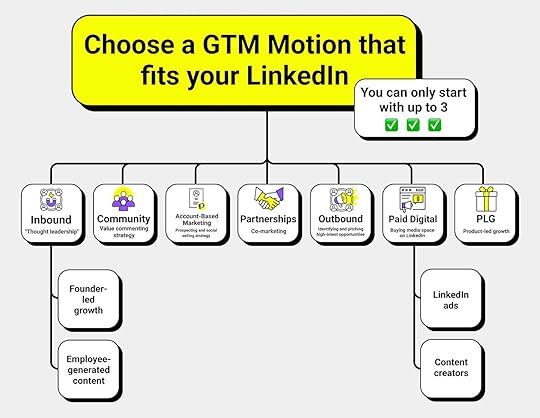
But which one to choose and how many resources can you allocate there? We will dive into different strategies of LinkedIn activities later, but for now, I want you to think about one important thing:
What is your goal on LinkedIn?
How will you measure the success in 2-3 months of investing in growing the channel?
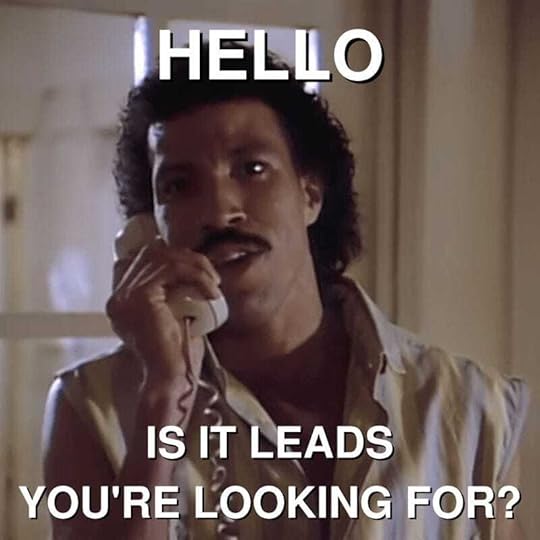
It is not the only game to play.
When I asked founders and experts in my network why they are willing to invest 4-10 hours weekly on LinkedIn, their answers were various:
PM from Supply Chain from Germany: “I want to reach 1 million impressions so that I can start making money from content—it is just a personal challenge.”
Go-to-Market Agency from Canada: “We want to attract different types of clients who would pay more for our services. This would be great for our positioning and, ultimately, lead gen.”
A brand manager from a 36 billion corpo from the Netherlands: “I want to raise my professional profile so that I can get better speaking gigs, invites to teach at universities, and climb the corporate ladder.”
IP counsel from the US from a 3.1 billion company: “LinkedIn is where I get the best knowledge from the community. I love to engage in comments to support my peers and attract new opportunities by adding value.”
VC from the US: “I am building awareness for my VC found so that we can generate more relevant leads. We compete against Y Combinator, a16z, and Sequoia Capital for the best startups.”
100K LinkedIn influencer with origins from India: “I genuinely just want to share knowledge and help people. I had it hard. Let’s make it a little easier for young people who want to take this journey.”
CTO from Poland in the AI space: “I say to myself that I post there to attract new talent and partners, but truth to be told - it flatters my ego that I am an opinion leader in the space. It has a lot of intangible benefits.”
What do all these great answers have in common?
They are business or professional goals. Their why.
What is your why?
LinkedIn is a tool to get something.
What do you truly desire?
That something can be an emotional benefit (status, ego, feeling of belonging, altruism - to help other people) or even an intellectual challenge such as:
“Ha, all the LinkedIn content creator bros are telling me to post selfies. Can I create a post with 1000 likes without sounding like Ryan Gosling in the Notebook movie?”
I am not saying that this is the best business motivation, but one of my colleagues really wanted to prove that there is hope for an “intelligent life” on LinkedIn.
It will be difficult to gather a critical mass of energy, creativity, and time to get the ball rolling without your strength.
It is much like going to the gym.
You will do it if you are motivated to do something.
Overcoming the obstaclesApart from knowing the “why” and motivation, what prevents very intelligent people from stepping up their LinkedIn activity are the course of knowledge and imposter syndrome. That often reflected in statements like:
“I do not know what to write about.”
Well, ask your colleagues what are 3-5 things that you are absolutely best at and write about that. Or you can start by commenting on LinkedIn or sharing useful posts and articles by others. C’mon, I know you are subscribed to 10 other amazing newsletters.
“Eh, everyone knows that.”
How do you know that? Have you tried posting about it, and someone commented, “Tell me something I do not know?” Look, give it your best shot. Here is a tool that will give you insights into what is going on in your fields of expertise or interest. You can absolutely comment on that and present your point-of-view.
“I have a writer's block.”
I mean… I can let you go with excuses and cut you some slack, but that is not good for you.
Believe me, I know what writer's block is. I was sitting in my home for a year working on my book GTM Strategist for 4-6 hours a day, including weekends. The only cure to beat the writer's block is to sit down and write anyway. Sometimes you have to read something else or talk to someone because you need information and need to do more research. But really don’t wait for some magic moment of inspiration. Half of the win of LinkedIn is just to show up and do the work - comments, posts. You win by being consistent so suck it up and do it anyway, no matter how uninspired you may feel.
Oh, have I mentioned that my team compared my motivation style to Winston Churchill?

Well, guilty as charged. My way of loving people is helping them to get things done.
After you know your why and human-up to show up and actually do the work, the next action point is to select your LinkedIn strategy and execute it like the boss you really are!
5 Strategies of LinkedIn Activity: Choose the one that fits your goals and the resources availableThere are 5 different strategies of LinkedIn activity.
They all work. For each I will share an example you can analyze and estimate the resources needed to do it properly. But before we dive into the LinkedIn playbook, let’s get one thing straight - strategy 0 is to have a decent LinkedIn profile and LinkedIn page and to know your ICP. Starting without this is like spraying and praying that your posts will go viral. Not GTM Strategist style. Let’s gear up.
Strategy 0: IndexedLet’s do some housekeeping. Before you start, you need to:
Have a decently looking LinkedIn profile
Have a company page with at least a logo
List of your ICP & opinion leaders with whom you will engage
Just do not overthink this.
You can get there in a couple of hours this weekend if you are motivated to do this.
Here are some good resources that can help you nail this:
LinkedIn moodboard of perfect profiles if you are a perfectionist
Do not know whom to follow on LinkedIn? Ask your audience and observe with whom competitors are intersecting, and as you start writing and engaging on LinkedIn, your feed will improve and become a constant source of inspiration and new discoveries. If you do not like what you see on your LinkedIn feed, here is how you can curate it to get better. Hit the bell on their profiles and engage when they post new stuff - you can start by ringing a bell on my profile - I promise to be nice in comments 🤠- Great, now 19 more follows - go, go, go!

And we are ready.
Let’s get some work done now.
Strategy 1: Founder-Led GrowthNow, the fun part.
That is you, posting smart content and engaging with other opinion leaders and potential clients in the comments.
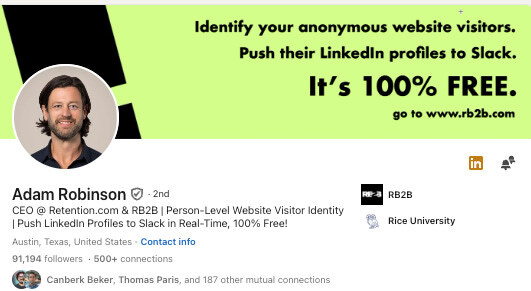
MVP (Most Valuable Player) in 2024: Adam Robinson
Result: Grew RB2B by posting organically on LinkedIn to $2 million ARR in 22 weeks using a LinkedIn-first approach.
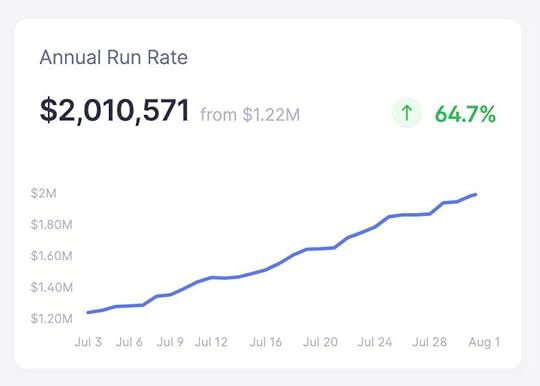
Secret weapons: 50K payrolls for content LinkedIn consultant (before, he had a ghostwriter), spends 40 hours a week doing LinkedIn and engaging in comments, huge on building in public. I loved his recent post on LinkedIn thought leadership ads - Adam shares numbers.
Start here: At least 1-2 hours a day for publishing content and engaging in public. Book a permanent slot on your calendar for daily engagement and posting—30 minutes if you will be posting content and 2-4 hours for content creation if you will be creating content. Consistency is the key. Try posting 3-4 times a week. At least one of these posts should be “built-in public.” It will help if you have a designer or at least invest in Canva Pro and develop some tool templates. First impressions matter when it comes to LinkedIn posts, but great content still triumphs over cosmetics.
Here are more examples of how Adam and other experts use this strategy and a deep dive into Adam’s strategy.

Bottom line: add value.
Do not simply reshare the company’s posts.
Develop your unique PoV and engage in conversations a lot.

How about if you do not want to do it or find it too risky or time-consuming?
Well, others can do it.
Strategy 2: EGC (Employee-Generated Content)Maybe the founder cannot or does not want to do founder-led growth. Here is some good news for you: by activating 3-10 employee profiles in your company and encouraging and empowering them to comment or post on LinkedIn, you can achieve great results really fast.
Based on my samples, when done right, posts from personal LinkedIn profiles get at least 10x more reach than company pages. Now multiply that by 3-10x and imagine the power of EGC.
MVP in 2024: Clay + external + internal influencers
Let’s review some of them:
Bruno Estella (CMO) is the mastermind behind this approach

Patrick Spychalski, Head of content, does amazing video tutorials and often speaks at webinars/events. They even organize weekly webinars now. They are killing it.
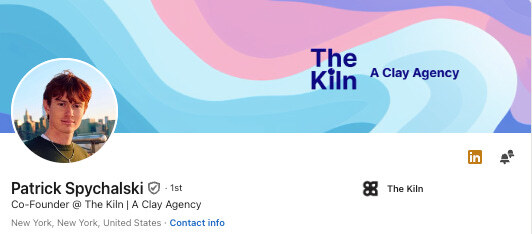
To grasp the full genius behind their approach, let’s view another profile. Alex Lindahl and his team are pioneering the term GTM Engineering, which is super interesting. In our brief conversation, he mentioned: “I have a strong PoV that GTM should be differentiated just like a product and that the best companies do this well and is a significant reason why they succeed.”
Yes, Sir! The best GTM Strategy is a priority and you provide a shiny example of it by “inventing the category” and writing your Substack (http://clayautomation.com/).
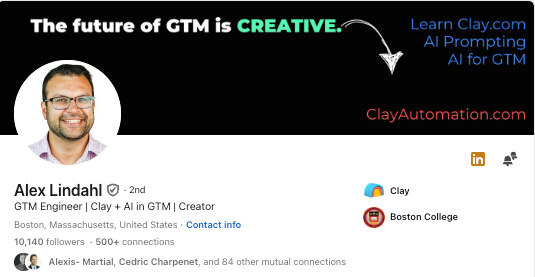
Result: We see Clay everywhere. They popularized a new category and communities + incredible hype when they got to $500 million validation.
Secret weapons: Carefully observe Clay’s positioning in the space. You will learn a ton, paired with external influencers, and incredibly responsive partnerships.
Unfortunately, I do not have much insight into Clay's internal engagement strategy just yet, but I will try my best to get it. For now, Adam will help.
I want to give an additional shout-out to Laura Erdem, Sales Manager of Americas at Dreamdata. I very much respect and appreciate her work as well. I could totally feature their team at Dreamdata in the EGC section too, but I went with Clay because they run a very interesting combination of internal + external influencers.
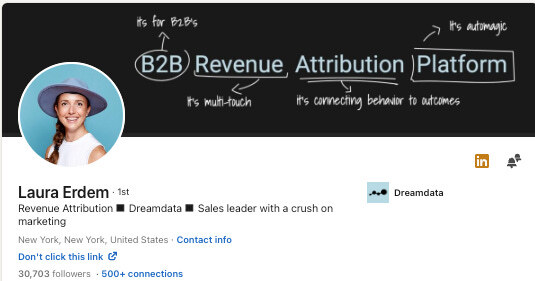
Start here: Empower 3-5 people in your company to form an EGC program. Educate them on LinkedIn and make sure they have the interest, time, and resources to do it. Weekly or biweekly meetings work best. We started to work on this with one of my clients. One of the business developers 10x-ed her reach in a week, went viral on X, and developed the first two relevant prospecting conversations in week 1 - she is incredible. You can expect the results really fast when this strategy is implemented properly.
I am working on an EGC playbook with some of my companies. If you need help with this, reach out to me. Please describe the challenges in detail so I can help or refer you to another field expert who can.
Strategy 3: Value Commenting Wiz“Do not post and ghost” is the first rule of a sustainable LinkedIn strategy. The real magic happens in the comments. This is where you can reach a much larger audience and get additional exposure to your profile and quality at PoV. The key is to really provide value in comments. People these days on LinkedIn hate AI-generated content. If you have a semi-decent lookup of Engage AI that summarizes the post in comments, you can now unlock the full benefit of applying this powerful strategy.
MVP in 2024: Have you ever seen a dinosaur on LinkedIn?
I have - in comments. 🦕
Mac Reddin and his team at Commsor. Commsor makes it possible to tap into your network of executives, advisors, partners, customers and more to find warm paths to deals.
Commsor’s team members walk the talk. Their vivid branding, high-quality assets, and lively approach that not only adds value but also brings smiles to peoples’ faces is a really clever approach. I asked Mac to share his blueprint with you directly. He kindly agreed.
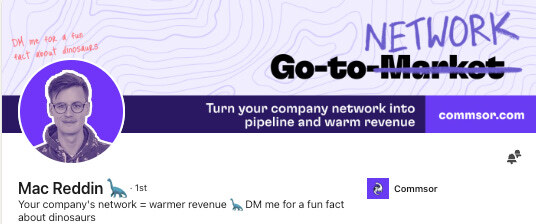
Result: “Results-wise, it's not purely because of comments, but so far this year 52% of our revenue has been sourced through LinkedIn presence of our team,” says Mac.
You see, it works best in combination with value posting.
Secret weapons: “I don't have any screenshots that necessarily prove the value of commenting, but some anecdotal bits that might be helpful:
We've closed a deal that came inbound because someone couldn't remember our name, but remembered the dino emoji and found a team member via that.
I've had single comments get more than 100 engagements, and often times comments drive more new followers for me than posts.
Good comments bring attention to you, which drives more people to see your posts.
Our company page has been called out multiple times recently for having the best comments. The trick here is to treat the company page like a person, not a brand. Ben on our team runs that and does a great job.”
Start here: Select 10-20 profiles that your ICP follows, ring a bell at their profiles and be one of the first people who comment. Comment at least 5-10x before you post. When you start doing this, be careful that you are not just spamming the links there but seriously adding value. You are penetrating to someone else’s community. Behave. 🤠
To nail this one, you need to really carefully select your ICP, engage early, and add value in comments. The good thing however is that once you do that, this type of content that landed well as comments (see your activity section on the profile) can be repurposed as a post. It is practically tested. Credits for explaining this approach go to LinkedIn expert Jasmin Alić.
Strategy 4: Repurposing Growth MachineHere is the good news—finally! You do not have to reinvent the wheel all the time.
What works - just works, and best-in-class content creators leverage that.
I have experienced the same image going viral 3 times on my LinkedIn, but there are people who take this the next level.
And one of my favorite people to watch is
MVP in 2024: Rubén Domínguez Ibar

I was lucky to meet Rubén in Madrid and he explained to me how he put this logic on steroids. He shared some data with us.
Result: In a single year, Rubén went from 3K to 130K followers on LinkedIn. In 6 months he also grew his Substack from 0 to 38K subscribers. He is simply incredible - really in it to win it.



Secret weapons: Consistently posting every day (at least 2 times per day), actively answering comments in the first hour after publishing, trying to find the best content possible out there to repurpose it, and giving credit. Rubén is sourcing newsletters, news pages (sifted, axios, pitchbook), and LinkedIn feed. He says: “LinkedIn does a great job showing me only Startup/VC content.”
Start here: Hit the “Save” button and revisit saved posts on a regular basis (set yourself a weekly reminder if needed). You will learn a ton. Test sharing visuals of other content creators and credit them. Do not just repost; try to post natively because the reach will be much better. Doing that does not make you a parrot; it is a smart thing to do, and OG creators will likely engage too. Do not fix what is not broken.
This one was hard for me to implement because I pride myself on being an original thinker, but then I started repurposing my own content. Experiments I ran clearly show that my best-performing visuals will continually outperform all others.
See my repurposing in action in my LinkedIn posting routine You can do this with any best-performing graphic or knowledge asset (whitepaper, ebook, slide deck, blog article, video) that you have.
Strategy 5: Outbound NinjaNeither have time nor patience that the inbound would yield results? Just finding the idea of doing so much work and sitting around for leads to land in your inbox off? No problem: LinkedIn has got you covered for outbound, too.
MVP in 2024: Arnaud Renoux

Arnaud runs a lead generation agency (The Scalelab) and a SaaS - Sales Navigator extractor (Scalelist). He shares a lot of practical rather tool agnostic content on how he does prospecting on LinkedIn.
Secret weapons: Every day, Arnaud contacts 5-10 new leads who match his ICP, and who already know about him and his product. It’s a 3-step-process that takes less than 10 minutes, and he described it in this post.
Start here: Cold context LinkedIn outbound rarely works. The easiest place to start is warm outreach. If an ICP engages with your post, you continue the discussion there and then transition to your email or DM. Remember: the first job to be done is to engage them in a conversation, to start the discussion, do not directly send your Caledny virtual coffee networking link - that does not work. Build trust, likability, and context first. Would you go on a date with a person who shouts at you “Go out with me” on a street? Yeah, though so.
So what will it be, dear GTM Strategist?
Which LinkedIn strategy did you choose to step up your game in Q3?
The easiest place to start is value commenting, then transition to content repurposing and, later, more advanced strategies. And remember, half of the success is just showing up every day and making sure that your activity adds value and is centered towards ICP.
Small acts compound.
Most people will give up in <1month.
If you set a repetitive 30-minute daily reminder, you are probably already ahead.
In the end, do not do it if you think it does not make sense for you.
Choose your battles.
I recently learned that the opposite of the FOMO (Fear of Missing Out) is the Joy of Missing Out.
Instead of guilt-tripping yourself for why you do not do something, enjoy the fact that you will miss it. I am trying to practice this mindset for all the 80% of webinars that I do not show up for.
If after reading all these examples you still objectively think that the ROI of doing this is not convincing enough, you saved yourself hundreds of hours in the next 3 months by not doing it. That is still a win.
Before we say bye-bye, I would just like to share with you a couple of exciting updates from my business:
🔥 News from the GTM StrategistEpic collab with Product leader Pawel Hurny - The Product CompassI was amazed to work with Pawel on a recap of our most popular GTM concepts.
Pawel is a content machine and I mean that in the best way possible. His point of view on Product Management is world-class. He shares so many useful frameworks, and I was blown away by his knowledge and professionalism in his content creation and distribution process. What I respect the most about him is that he is, like me, still an operator. There is something magical about people who are authors and doers.
Job: Digital Marketer at Growth LabThis weekend is the last chance to apply for a Digital Marketer role on my team. I will be working closely with this person on our content, digital funnels, and new knowledge assets. Learn more about the role.
We are blessed to have some really strong applications from LinkedIn, but I wanted to share this via my Substack there in case you missed the job opening.
On Monday, we will do the application screening and select candidates that I will interview. The role can be part-time or full-time.
Product update: FREE update to GTM Budle: Gallery of my best-preforming LinkedIn posts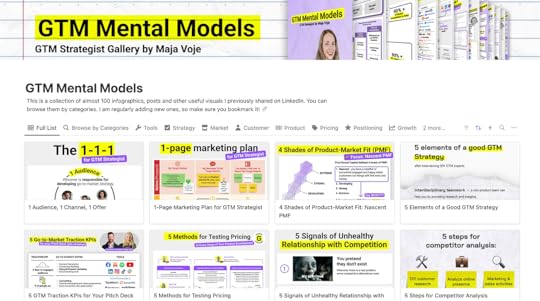
Last but not least, to increase the value of the GTM Bundle ($47), I added one great additional asset to it at https://gtmstrategist.com/.
GTM Strategist Mental Models Gallery unites all the (non-memes and video) posts that I have published on LinkedIn since the book launch in November 2023. You can find almost 100 infographics, schemes, templates, and recommended tool lists. The posts are neatly organized in Notion to follow book chapters, so you can easily repurpose them for your posts and slides.
If you already got the bundle, I already sent you a free upgrade.
If you did not receive it, just let us know at order@gtmstrategist.com, and we will take care of it as soon as possible.
These materials will not be shared elsewhere.
In case you are new to our GTM Strategist squad, this is a product that we upgraded:

Until next time,
Maja
July 19, 2024
How AI products Go-to-Market

This Substack post is kindly supported by CommandBar, all-in-one AI-Powered User Assistance (onboarding, activation, chats, support assets, etc.) used by 20 million users and best-in-class companies like Clearbit, AngelList, ConvertKit, Gusto, 6sense and many others. See what they do here: https://www.commandbar.com
Dear GTM Strategist!
Let me reveal a secret …
I have been working on 24 AI-first projects in Q2 and I am building a new AI-based product myself (stealth mode for now, but I promise you’re going to love it).
Long story short - GTM for AI-first products is different.
In my experience, it is easier because we can ride the momentum, and almost every team that I have been working with got 1000s of registrations, 100 weekly active users (in month 3) and 50 paying clients with 0 budget (posts to groups, social media and outbound). The blueprint for how to promote these products is simple. Pricing, retention, and positioning of AI products are not.
I am working on advancing my frameworks to serve AI companies even better and I started to systemize my learnings that will primarily be presented as a case study during my keynote “What is the Go-to-Market Strategy for AI Products?” at Product Drive Summit. You are welcome to register. It is free, and the speaker lineup is amazing, as always ✌️
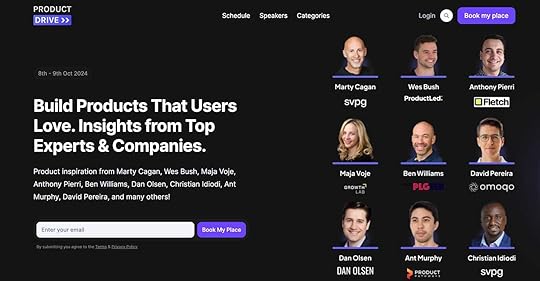
By now, I firmly believe that by 2025, the adoption of AI will be not just a trend but a necessity for every company. It's high time to start planning your AI strategy.
But … hooking up a random chatbot to your website and using ChatGPT to write your LinkedIn posts is so 2023.
As AI is maturing so should we.
The days of AI romanticism will soon be over.

As with anything in tech, AI solutions can be used:
To enhance productivity and increase the efficiency of existing processes by buying or developing AI solution - this is the easier place to start for most companies.
To add new features, capabilities, and business models to advance the business and develop your own solutions where it makes sense.
In this Substack, I will invite you to:
Explain AI to Martha from LinkedIn: Understand the fundamentals of AI by grasping the architecture of AI solutions, my thoughts on how the landscape is evolving.
Use case 1: Use AI solution to advance existing processes: We all know you can make a lot of money if you fix activation in your product. CommandBar’s AI-powered user assistance has some cool features that will delight users and add value instead of annoying them with pestering pop-ups.
Use case 2: Launch your own AI-product & open it to others: Analyze a case of how Rewriter (GTM PLan how to get 1000 users with 0 budget)- a LinkedIn post generator trained on 60,000 viral LinkedIn posts - attracted alpha, beta, and public beta users —free as always. I have been with the maker since alpha version and we are just getting ready to launch open beta.
3 mistakes to avoid when launching an AI Product: I end this Substack with main lessons learned from my recent AI launches. Coz why not? 🤠
We will make AI friendly for non-technical people.
You will grasp it in a sec, I promise.
For all the tech folks, let’s make you some money with your AI superpowers!
Buckle up and let’s do it!
A quick intro to the AI landscape and core issuesLet’s first align our understanding of AI. In 2024 the investments in AI solutions will continue to grow. There is a running joke among my VC friends to run “command + F” search on pitch decks and count how many times a startup mentions the word “AI” in their pitch.

AI is not a new technology. It has been around since the 1950s, some would argue even earlier (learn more about the history of AI if you are a true history geek such as I am 🤓), but ChatGPT is the first widely adopted consumer usage where users are directly exposed to AI and as such impossible to ignore. ChatGPT by OpenAI is the fastest service got 100 million users which they managed in 2 months in 2022. As of this writing, ChatGPT is estimated to have 200 million active users and over 600 million monthly website visitors.
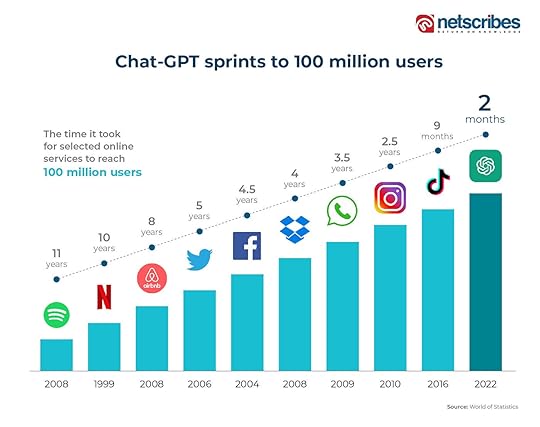
I believe this is one of the best product-led, value-first user-inclusive examples I will ever see in my career. What made ChatGPT so successful? I’d argue that low entry barriers and time to value - the tool is free to use, produces amazing value added in seconds, and solves real pain points. And we are just getting started:
The technology behind it is called generative AI. In a nutshell, it takes a prompt (a snippet of text or other media) as input and produces a stream of output in response to and based on the given prompt. While the most common combination is text for prompt and output, that need not be the case. All of the state-of-the-art generative AI systems are multimodal, meaning they can take input and produce output in multiple formats (e.g. prompt is a picture and some textual instructions, output is synthesized speech).
 This is the image output for a text prompt “lipstick on a pig”
This is the image output for a text prompt “lipstick on a pig”What makes this iteration of AI super accessible and enticing is that while most people cannot code, but they can write prompts 🤠- especially when they can start experimenting free of charge.
While it is easy to get hyped about AI, let’s establish a basic understanding of the different layers of AI solutions. Most AI tools that you know are AI applications (ChatGPT, Jasper…). But in order for these apps to work, we need other layers too. ChatGPT is built on large language models developed by OpenAI, such as GPT-4. And in order to develop and train those, you need computing/processing power. A lot of it.
Now things get interesting. Most competition is on the top application layer, but the most profits and investments are on the bottom layer layers (infrastructure, inference, compute), which are dominated by big players such as OpenAI, NVIDIA, Google, Meta, Amazon, Anthropic - you know - the usual suspects. That creates a critical dependency in the system - if they change the terms/availability/price of their services for applications, the market changes.
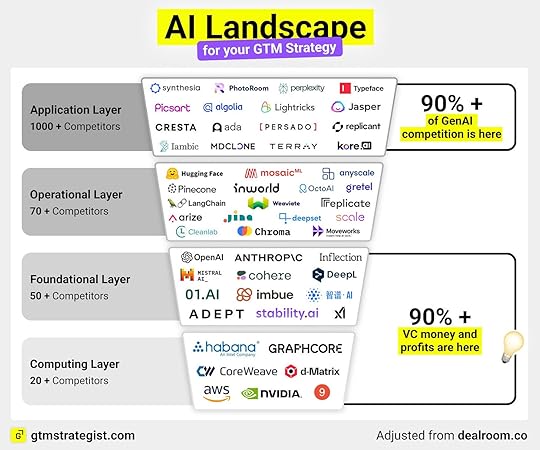
We have seen this before with prices and limitations of media buying (paid ads). As Meta changed the advertising algorithm or Apple pushed new privacy policies, we saw a drop in performance and a scramble in the market to adapt. Not all companies managed to adapt, though. For some, each change like this was fatal.
Will access to AI become the “new wi-fi”? Something that is so ubiquitous, accessible, and affordable that we experience it more as infrastructure like running water than a high-tech service?
I think so.
However, I do not believe that GenAI is the final frontier of this evolution. I see “TRUST” as the most important currency of the future. If the information I consume on the internet is generated by AI agents known to have hallucinations and synthetic data, how do I form my perception of reality? Whom or what do I trust?
While access to information seems to be a commodity, the quality (trustworthiness) of information and the ease of getting it seem to be the new frontier of how we are evolving as a society.
Furthermore, even the existing market leaders are already thinking beyond large language models that underpin the current generation of Gen AI. Introducing a notion of planning into generation is one such promising approach. Personally I am also very keen on ideas around using knowledge graphs to better encode the real world and make reasoning less opaque.
While currently the majority of money flows into the lower layers (and is quite concentrated on just a few players), I could see that changing rapidly once we get more non-trivial functionality on the application layer. Currently large swaths of the application layer are just wrappers around ChatGPT, but what about once we start talking about data provenance, added value of data (and accompanying payment rails and microtransactions), data interchange, centers of trust…
And this is just the what. Also with the how I expect big and rapid movements on the market. The applications of AI to interfaces will be phenomenal. We are moving away from overdone interfaces and solutions are becoming more subtle. At the end of the day, we care more that the job gets done instead of who, what and how is doing it.
In terms of adoption, users will not try something just because you write “AI-first” as a headline on the landing page. Whenever you position something as AI-something, users will anticipate a 10x solution with very low time to value, usually provided for free and within usage limits. Do not put lipstick on a pig - think value-first.
We agreed that AI is important, here to stay and we should do something about it. But how?
How to start thinking about that?
My core principle is not reinventing the wheel whenever I need to optimize the existing process. Of course, you can build your own solution, but that needs to involve engineering and you won’t have the feature set of a product that’s been purpose-built for years.
If someone has already successfully solved a challenge unrelated to my core business and not within my product vision, I would definitely prefer to buy a tool that “hooks up something” and train it on my limited data samples. Usually, it is cheaper, better and faster.
When we talk about activation, it is often mistaken for onboarding—getting the user to experience the value of the product after the signup. In reality, activation starts much sooner than signup and continues beyond the first inception of the “wow moment.”
Emails, creepy support agents bots and annoying push notifications will be ignored. To truly make a difference within the product, modern-day SaaS providers and apps need to think way beyond that. Recently, I discovered a really cool visualization prepared by Kate Syuma, the author of Kate's Syuma Newsletter and Growthmates (ex-Miro Head of Growth Design):

CommandBar gets that. Instead of focusing on the onboarding experience alone, it offers powerful in-product engagement tools, intelligence and integrations to holistically tackle the activation challenge.
At its core, CommandBar is software that makes other software better for users. They call it a User Assistance Platform, and it comes in 2 pieces:
Nudge Platform — AI-assisted nudges, hints, and messages to guide users in personalized ways that don’t annoy them. They do this by optimally delivering nudges based on in-product behavior and not just static rules. They also measure the extent to which users “rage close” nudges to avoid pestering them.
AI Agent — an AI chat agent that can answer users' questions, perform actions for them, and even co-browse with them to teach the product’s interface.
As I dived into CommandBar and its references, I actually discovered that I have been using it for the last year or so without even knowing 😅
How come? We are using ConvertKit for our transactional and drip email campaigns, and I had a couple of very profound chats with their support chat. Little did I know it was an external tool because it is so seamless and beautifully branded.
I recorded a video overview of why CommandBar is one of the best customer activation tools available to SaaS companies. Remember: AI hallucinations can cost you reputation, time, and money.
As I wanted to dive deeper into this compelling product vision and vision of how user activation will evolve in the AI era, I invited James Evans to share more about the future of activation for the GTM Strategist podcast. One of my favorite parts of this episode was when he explained that they positioned CommandBar as a horizontal product - serving many industries for a similar use case.
Listen here:
You can capture the benefits of AI-assisted activation, get powerful purpose-built features that will improve activation and overall user experience and without investing 50-100K on your custom LMS solution development if that is not your core business.
But what if all the solutions to the problems you repeatedly face fall flat, and you see a window of opportunity? That might be considered developing yourself …
Case 2: $0 budget launch plan for RewriterMeet Tim Berce, my long-time friend and business partner. He is one of the best copywriters I have ever had the pleasure of working with. For years, we have been telling him that he should write more LinkedIn posts because he is a supremely talented writer, but that was simply not his spiel.
But he liked AI. Tim was one of my first colleagues who adopted OpenAI solutions before it was cool. So far, he has built several AI-first products, including:
Enterprise solution for writing perfect sales emails for a client
An app speeding up getting products to market for large retailers and marketplaces.
A smart email assistant
He needed to attract B2B clients for those tools, so he had to step up his LinkedIn game.
Tim is all about effectiveness and 80:20 rule.
Copywriting for LinkedIn is daunting, and as a busy venture builder, he cannot allocate 4 hours a day to writing about his cats and making valuable comments on other people’s posts.
He did what he knew best.
Tim trained the model on 60,000 viral LinkedIn posts and launched v01 of Rewriter.
First, he used it for his posts: https://www.linkedin.com/in/timberce. Tim scheduled a bunch of content generated with Rewriter in advance. Since he has been using the tool, he has gained many new followers and well-performing posts.
It worked for him.
Will it work for others too?
I love people who eat that dog food, so I immediately joined his private alpha.
V01 was a spreadsheet that looked a bit like this for repurposing hooks for my LinkedIn posts:

In the meantime, Tim put together a simple interface in Wordpress and so far, there are approximately 100 users in his beta. How did he get them? Easy-peasy:
He shared his tool freely with friends and asked them for feedback.
Tim did a quiet pre-launch on LinkedIn and gave people free access in exchange for their feedback.
All other users came via referral as his users tried out the tool and recommended it to others.
The best thing is that the users retained nicely (35%+), a fantastic early signal of product-market fit. They are also heavy users: they already created more than 4,000 LinkedIn posts.
I use Rewriter at least once a week when I have random ideas for LinkedIn posts (outside my content plan) that I want to test quickly. Here’s how it looks like:
A critical assumption we need to test next is who is the best ECP (early customer profile) for Rewriter. Based on the feedback from beta users, there are 4 hypotheses who can best benefit from the tool now:
Busy founders of small companies that want to write content on LinkedIn to get new leads
Copywriters and ghostwriters who work with multiple founders
Inhouse content creators that have to repurpose their content for LinkedIn
Influencers :D - professional content creators (15K+ followers) who spend more than 10 hours a week on LinkedIn and post at least 3-5x a week.
How will we know which is the best bet?
Easy.
We will launch and reverse-engineer data on who is most likely to activate and convert.
Tim and I had a launch planning session this week. The objective is to get from 500 (Tim’s bet) to 1000 (Maja’s bet) users, who will eventually become 20-50 paying customers.

Rewriter will launch in late August. To support the launch, we selected 3 free GTM motions.
Communities: Post to Facebook groups where target users are active.
Inbound + PLG: Brand posts created with Rewriter to create a growth loop
Outbound: LinkedIn DM & outreach to selected contacts.
Bonus points: Get 3 influencers to share it because they really like it. I volunteered to support this launch and one 105K+ LinkedIn influencer is also interested. Fingers crossed 🤞
It is simple, actionable and free.
If you like Rewriter, you can still get early access.
3 things you should not mess up when you launch an AI appYou see, Tim did not plan a Product Hunt launch. He will not present his side hustle at an event or spend money on ads to promote the tool. He will DIY this launch in probably a day. User referrals are already kicking in (this is a user referral, for example), so we are very bullish on the odds of this success.
How so? Because I have seen it working again and again.
One community member got 1000 users by posting to 3-5 local Facebook groups. I could not believe it. He showed me the stats.
If the value is there, users will follow and recommend it.
If the product is great and beta users love it to the extent that they already invited other users to join the program, we are likely to have a winner.
Most launches are completely overengineered, too expensive and unfocused.
You do not have to be a rocket scientist to get 1000 users for free - the best GTM for simple products such as Rewriter should be lean and actionable.
Use this template for your next launch if you agree with this line of thinking.

After we agree that launching an AI-first product does not have to be rocket science, let’s list some specifics you should consider for your own launches and offer more helpful sources.
Product: Beta or inception program is practically inevitable. At first, the product is likely to suck a little, and you need users who are passionate and patient enough to get it in a shape where it delivers value without your troubleshooting. Those users will also be your early ambassadors. You can get their reviews, and they will invite others to join. Definitely do not leave this one out.
Value prop/positioning: AI per se is not a differentiator. Probably the most brutal conversation I had this week was with someone who wanted to sell me 5 consulting hours. Look, I do not care about your consulting hours - you might be selling this, but I am not buying it. I care about how you can prepare me to nail my presentations in Q3. Name a price for that. It is harsh, but it is true. The same applies to AI - I do not care much about how this is done. What I care about is how I benefit from it, what are results I can expect from it and why you are the best solution to get this job done. That is it. FAB model (Feature, Advantages, Benefits) is a wonderful and simple tool that will help you get better in communicating your added value. Credits to Userpilot for sharing your example:

Pricing: AI usage has considerable costs - If you are developing an AI app, you will have real costs with “free users” beyond the marginal costs of web hosting services. Sure you can apply for inception programs for AI models and other players in the game to get free credits to build, but start thinking beyond that. You will need to reflect this cost in your pricing. Study this epic Substack post by Kyle Poyar so you will not get broke if the free users love your product too much.

There are many many more lessons that I have learned from working with dozens of AI products. It is my new favorite thing to do. My learning curve is exponential ATM so imagine how awesome my presentation at “What is the Go-to-Market Strategy for AI Products?” will be - apply here.
Cool, I hope to enjoyed this one.
If not - reply “Maja stop being so obsessed with AI” to this email or in the comments.
If yes - hit a heart ♥️ on Substack and send me more questions.
♥️ Credits to post contributors: The quality of this post is a result of fruitful long-term collaboration with:
AI part was fact-checked and improved by Simon Belak, data scientist and CTO (prev. Metabase, Zebra BI). He is one of the most intelligent people I have ever worked with. He never agreed that I put CTA next to his name, but I usually rely on him for complex analytics and data scient projects and technology leadership advice.
CommandBar team kindly pitched in with more insights on activation and their AI features.
Huge thanks and kudos to Tim Berce for having a true growth mindset and for openly sharing his data. #buildinpublic.
And to my team for all the awesome designs and editing this Substack. You are the best.
Let’s go to market with our AI-powered products!
Maja Voje
Are you launching in September, October, or November 2024?Set up solid fundamentals to nail your GTM.
DIY: Go to https://gtmstrategist.com/ and get your 100+ GTM Checklist. All the frameworks you need to plan your launch are there.
Done with you: For long-term consulting, I am booked till November, but if you just need a short session (90 minutes) to make sure that you are focusing on the right things, I can do up to 10 individual consultations in August. I just had one yesterday. We nailed positioning and crafted fundamentals for their launch. This is how the process looks like - we make things happen!

You can apply for a personal consultation ($400):
July 12, 2024
Unleash the Power of Communities

This Substack is kindly supported by folk CRM - in my experience, the most user-friendly, non-complicated CRM out there. You do not need 300 custom fields to get the job done. This time I will show you how to build a list of 20+ B2B Influencers from LinkedIn, easily import them to CRM via Chrome PlugIn, find their emails, and send them a collaboration idea in <10min. Watch the video 👇
Dear GTM Strategist,
Let’s get real—yes, there are 7 Growth Motions, but unless you are sitting on a pile of money, you will have to prioritize those that deliver measurable results FAST and (almost) FREE.
Well, what could that be?
Here is a hint …
Nearly half of the B2B companies use Community-Led Growth to scale their GTM efforts (source: GTM Partners Research, 2023).
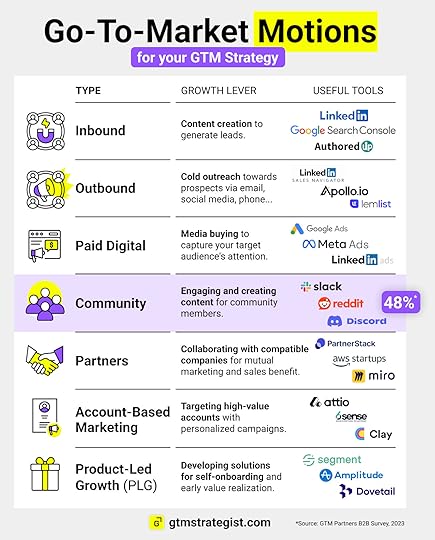
It is fair to say that I would not be where I am today without utilizing communities on my go-to-market mission, professionally and personally. I have learned so much, met the industry's brightest people, and had many great business opportunities.
Some examples where community was a core GTM Motion for my career.
When I was a CMO at OriginTrail, the community was our key GTM motion for raising $22.5 million for development. It continues to be an essential pillar: Last week, the team had 17K+ streamers on X supporting their new launch - on the 4th of July from all days. Their traction is incredible. 🙌 #funding
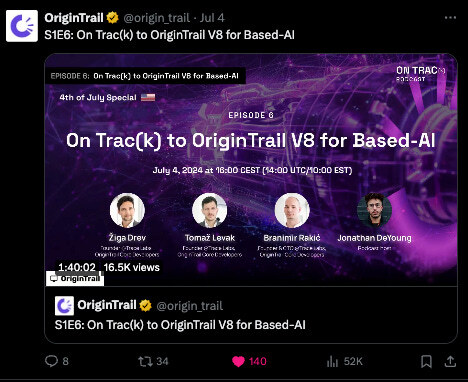
Building a 13K local Facebook community gave me an opportunity to invite Sean Ellis to speak in my home country Slovenia. This event and connection created a huge lever (from leads from this event, I made +$100K with retainers over the next two years) and positioned me on the global roadmap. #positioning

I co-hosted the ProductLed podcast with Wes Bush and Ramli John pro bono for 2+ years, during which time I met many interesting experts, including Leah Tharin, Elena Verna, Ben Williams, Chris Walker, and many others. This experience unlocked numerous speaking and content-creation opportunities. #networking
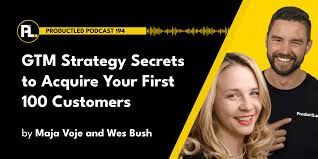
LinkedIn community generated 3000+ signups for the launch of my book Go-to-Market Strategist, which sold 600 copies in pre-sale—enough to hit the best-selling badges for a week. And the rest is history. #presale

And the list goes on and on and on.
These would never happen without communities. 🙏
Do not be mistaken for a second that it was serendipity, aka “it just happens.” You have to be very consistent. You have to give, give, and give without expecting anything in return over a long period of time, and then one day (measured in months or even years), something wonderful happens. It is definitely a long game.
And you might be thinking: “Maja, I get it.”
You spend a lot of time online, and you like meeting new people.
But is community really a worthy GTM Motion for me to invest in?
We have 3-18 months or runway to make it or break it.
In my portfolio, communities worked well for 97% of the 650+ companies that I have helped with their go-to-market strategy, from traceability software solutions, dog supplements, CRMs, and AI-first products to liquid cooling solutions for hardware.
Why?
💡 Because you do not have to build your community to leverage this powerful GTM motion.
Building your own community takes a lot of time and effort.
It is a cold start problem.

Instead, you can penetrate existing communities where your target audience is already actively learning, seeking guidance, and discussing their business challenges.
In this Substack, we dive into:
Practical theory: Types of communities to consider
Case #1: Extreme case - My freelancing class: How no-name freelancers got clients even without any portfolio experiences by value commenting and posting
Case #2: Established company: Lessons learned from my conversation with growth marketer Esther Trapadoux who is Head of Community at Amplitude
Let’s bring it all together: Elements of a thriving community and how to create one (Community Canvas by GTM Strategist)
Let’s get this party startin' 🎉
6 types of communities to consider in your GTM StrategyCommunities come in many different shapes and sizes. From a community of 12 people on a mission to think about the future of AI at a founder's retreat in Bali to tens of thousands of people on a mission to advance an open-source product with their GitHub commits.
There are 3 pitfalls GTM experts often make when defining a community as a GTM lever:
Community = channel. Many think that Instagram, LinkedIn, and Facebook profiles, where you publish your content to generate a couple of likes and comments, are communities. For the purpose of this post, let’s agree that those are social media channels, not communities that can be built across platforms. My community, for example, spreads over LinkedIn (comments and DMs), discussions after I publish my Substack, and networking calls that I sometimes do. It spreads across different platforms.
Admin = the king. Your newsletter is unlikely a community if you do not get massive replies back and vivid interaction in comments between members. The community's DNA is that members interact and help each other to create synergic effects. The community effect only happens when members activate and start helping each other. Communities are not about you - they are about them (the members). Becoming obsessed with added value for members is the best recipe for building thriving communities. The secret is that you create enough goodwill and added value to trigger the effect of reciprocity and the “top of mind” effect. That can only happen if you are consistently a great contributor.
Solely wearing the sales hat. While the idea of having thousands of people who will gratefully grasp your new product or discount deal is tempting, it is unlikely that it will work. Communities have to be nurtured and managed carefully. Yes, they work as a sales channel too, but you will have to earn the right to sell there.
After you avoid these pitfalls, the next question to tackle is what shapes and forms communities take.
There are free communities and paid communities (yearly fee $500-20,000, median $1,000).
There are open communities and private invite-only communities.
Humans have always been tribal beings.
Channeling my inner Peterson: While gorillas are stronger, humans dominate as a species because we have formed collaborations. We always gravitate to connect with like-minded people who share our interests and identities and try to create synergies to advance our pursuits.
I like to use jobs-to-be-done in combination with motivation to create a list of communities to consider on a GTM journey. My underlying logic here is that humans work well together if they share a goal or receive benefits (recognition, payments, value-added that they wanted - i.e. knowledge or emotional benefits - form new bonds and friendships).
Here is how I systemize them based on jobs to be done (with examples):

If you have any other classification of communities, I am eager to work with you on v02; hit me up ✌️, but after careful consideration, this is v01 I propose.
Now, let’s hop into the trenches.
How can we unleash the power of communities as a GTM Motion?
Case #1: Leverage external communities as your Go-to-Market driverWhen you launch your own community, a handful of members will be there. You will have to engage fiercely to demonstrate the value added for them and deserve their continued attention. You will also have to create new habits for them to start paying attention and visit your community frequently to convert them to active members.
Sounds daunting?
It is. Been there - done that. You too?
🦗🦗🦗
While building a community of raving active members is a really powerful asset, I do not like to send my GTM champions on such a mission without making sure that we have some good leverage.
If you have a pre-existing audience, you can go ahead and start thinking about your own community (next case), but if you are just starting out, you have a much better fighting chance if you penetrate existing communities and build traction there before going solo.
Go where the audience already is.
How do you know that?
Ask them.
A simple email could be an amazing source of intelligence, like this email an engineer sent to learn more about where his customers spend their time:

You can do it even more casually by asking field-relevant people on LinkedIn what they would recommend, make a list and see if these communities are a good fit for you.
C’mon, do it - it takes 30 seconds and saves hours of desktop research.
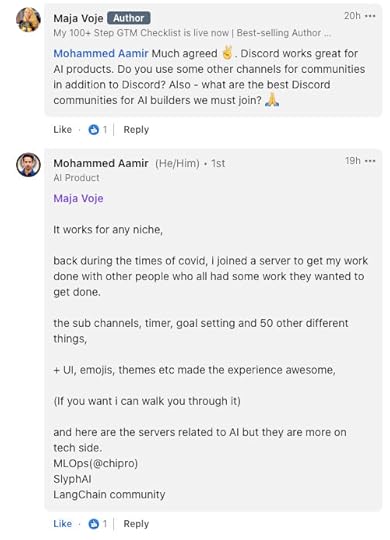
After you know which communities exist, you can start planning how to penetrate communities where your target audience is already actively learning, seeking guidance, and discussing their business challenges.
But don’t just go there and smash your link - the admin ban hammer sways hard. 🔨
Add how to add value first before you earn the right to “go promo”.
My greatest learning on how to do that with grace and respect comes from my freelancing course business venture. My partner Tim and I helped 200+ local freelancers to launch and grow their businesses. It is a vivid group of marketers, developers, creators of edu products, designers, and other field experts who are interested in launching their own businesses. Most of them did not have established personal brands, audiences and shiny portfolios, but work has to be done nevertheless.
For most freelancers, one of 3 ways how to win new business worked (in addition to warm intros, which you one day ran out of):
Super-targeted outbound with irresistible offer + value inside. This worked well for all, experienced and noobies.
LinkedIn and Instagram inbound strategy only worked well with people who have already built at least some audience and credibility before (measured in 3 months).
Value posting and commenting to selected communities where their ICP was present worked well for all who played by our rules.
What are the rules?
From being an admin in five 10K+ groups, I can tell you that the only way to “survive in larger groups and maintain quality” is to follow the group rules to the T (single source of truth) and give fast feedback loops to those who violate them. You know what I mean with that 🤠. Here is what we admins are allergic to:
Members who join to sell
Spam their links to comments and organize “shilling” with their friends
They only want to take, not give to the community
Being a “know-it-all” douche without any sensitivity and respect for other members.
This is why we recommended our freelancers to start their community mission with value commenting and posting. Only once they have delivered an insane amount of value for the community do they earn the right to publish a promo upon agreement with an admin.
If you are a new entrant to a community, show respect by:
Actually read the conversation, review channels/topics, learn the context of the group, and decide if they have a relevant PoV or advice there. Don’t just comment “great post”, but ask additional questions that appear intelligent and knowledge-seeking.
Your first activation should be a comment that adds value; produce at least 5 value comments in 5-7 days to build traction.
Your first post should be a non-gated, not promotional asset, which is extremely valuable for the group (think breakdown, analysis, case study, and lessons learned) without any call to action.
Give before you take. Esther (you will meet her in the next case) called it the Jab-Jab-Jab-Right Hook rule 🥊. Give, give, give (again), and then ask. I suggest 3-5x value posts in the community, and if they land well, I would ask an admin for permission to publish an offer, survey, event, or free consultations/work CTA.
Continue being active there. It is a long game.
Now you understand how hands-on penetration in a community can be. This is why it is not wise to join 100 groups at the same time and post your promo intro there, but you should strategically select a handful of relevant communities and build strong traction there. The overall results will be much better.
Remember, existing community members already like and trust each other. You are there as a stranger first and will have to earn their trust.
But the good news is that 80% of members in most communities are passive—they read, not create content. This is why you, as an active participant, can get a lot of attention and “power” there really fast and stand out. Use this power for good. ✌️
 Case #2: How Amplitude builds the community strategy
Case #2: How Amplitude builds the community strategyNow let’s move to more advanced use cases.
At the Product Hackers Conference in Madrid, I had the pleasure of meeting and listening to a wonderful keynote on PLG communities by Growth Marketer Esther Trapadoux who is on a mission of building a community at Amplitude.
One would think - oh cool, Amplitude is such an awesome company - they can send out an email and get 500 members to Slack in a heartbeat 🤠, but the story is MUCH more profound than this.
Amplitude has been celebrated as a great partner to other communities before launching their own community. I first learned about their community programs from Sean Ellis more than five years ago. They were always eager to support product and growth communities such as MeasureCamp, Reforge, Product at Heart, and countless local communities. It is in their DNA.
Creating their own community was frequently discussed and had an internal buy-in.
Amplitude was established in 2014 but only launched their community recently.
From the first-principles thinking, the right question to ask: is “Should ____ even have its own community? - Why?”
Esther explained: My colleague and mentor John Cutler and I had long discussions on the added value of Amplitude’s community for the members.
This is what planning for Amplitude’s community looked like:
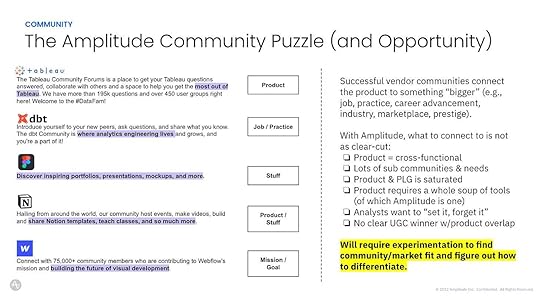
A big part of the process was going deep into our assumptions, risks, and getting crisp on the community’s core values.
As mentioned above, it was important for us to acknowledge the risks that we would not be able to find Community-Market Fit. We broke down the biggest risks and built-in key actions in our early roadmap to help de-risk our bets. (Or maybe, in the end, we prove our fears true and there really wouldn’t be demand for an Amplitude community.)
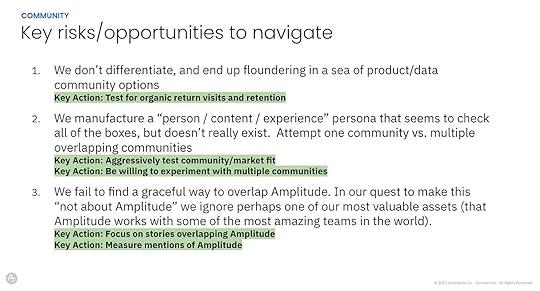
There’s a great article that says community building (and decision-making) comes down to four categories: people, content, member experience, and technology.
We took this framework and ran. We knew we needed to nail these things in a specific order, creating value first and then figuring out how to grow and scale. Looking back, and this was mapped out towards the end of 2022, we’ve followed this rough roadmap pretty closely.
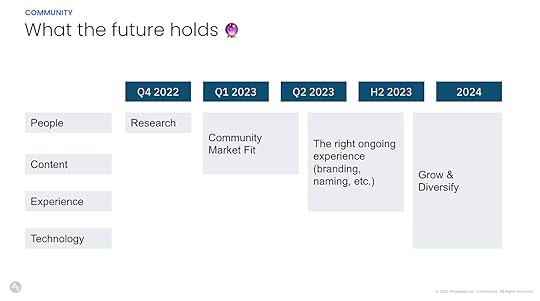
After developing a value proposition for the community, Esther kicked off community operations. From what I have seen, they are really in it to win it. Not afraid of doing things that do not scale and within the value system that works for communities. Here are some of her best practices that you can consider:
Find the fastest path to learning. Experimentation and fast feedback loops are central to how our team operates. We probably need to slow down at this point and spend more time looking back. But in those early days, when we were manually pumping the community flywheel, we did our best to keep tests light, fast, and iterated quickly. This was the only way we could start spotting signs of life.
Do things that do not scale. Esther commits to book interviews, really meeting members, and discussing with community members what they need and how the community can best support them. She explained: “Amplitude plays a small role in their busy and vibrant work life. It is so valuable to learn what that role is and how Amplitude fits into a broader picture of how they work. These insights are invaluable for product and marketing as well.
Make community members heard. Instead of inviting (only)) flashy speakers, empower community members to share knowledge and exchange experiences. Many of them have incredible knowledge but are not frequent public speakers. Help them prepare for the event and empower them to thrive.
More than community - it is a support system- Esther loves to support members on LinkedIn. She mentioned: “I am very interested in how community members advance in their careers. Not only to celebrate their achievements, but Amplitude also prioritizes supporting active community members who lost jobs and either initiate connections or feature them in their newsletter to support their job quest.” It is definitely more than a job.
In the meanwhile Amplitude still works closely with external communities. They have a thriving community of 15k+ members who are joining community programs, attending user groups, and exchanging ideas online. This also includes 3k+ members on Slack and 4k+ members in their community forum.
Their core priority is helping Amplitude users in their analytics practice and to unlock growth in their roles and business. They want to see our members soar. If you don’t use Amplitude and want to level up your analytics game, you’ll still find value in their community. But don’t be surprised when they win you over. 😉Learn more and find your community at: https://community.amplitude.com/
Let’s bring it all together ✌️Over the years of working and being an active member of hundreds of communities, I believe that there is only one secret sauce to running a successful community:
A strong mission statement backed with shared values.
In simple words, why does this community exist, and what benefits does it bring to members?
If shared values and rules of engagement are the glue of the community, a clear mission is a compass and key to its longevity.
If you are interested in building your own community, try my GTM Community Canvas. It beautifully captures different elements and stages of community development. It is 100% derived from my experiences and tested to work with the teams I coach. It will help you make an actionable plan on how to onboard and activate the first 100, 500, and 1000+ members. While the tactics might change, the mission remains untacked.

To end this on a fun note so that I can repost into LinkedIn wherever I run out of content ideas 🤠 - here are 5 Community Management Lessons I learned from running agility with my two dogs 🐶🐶 in my garden🏡 . They work.

Once is always - never keep your guard down. They will push your limits and stay consistent.
There will always be a hierarchy. There can only be one pack leader. It is either you or the dog.
Intelligent life needs to work. Dogs are domesticated to work. If you do not keep them busy, they will find their own ways to get busy. You probably will not like that.
Progress is lost if you do not practice. Reps are the key to progress. Dogs and humans alike need routines and habits. We are learning by doing. Plan your activities in advance and stick to the schedule.
Make it fun and rewarding. During intense training, the dog needs to rest and get rewards- play, food, and petting. Rest and appreciation are part of the training. Positive reinforcement works wonders.
😁Gosh that was fun.
And that was it, dear people!
Thanks for reading.
Reply to this email or comment if you have any questions, cool experiences, or ideas on how we can improve this Substack.
This is one of the subjects that is near and dear to my heart, and it is definitely not a one-off post. We shall return to it again.
Till then - thank you for being part of the GTM Strategist community ❤️
You are my why, and I appreciate you to the moon.
Let’s go to market!
Stronger together ✌️
-Maja
Are you ready to dive deeper and work on your Go-To-Market strategy and execution?Discover my solutions that support your journey from launching to scaling:
🛰️ Explorer: Understand Go-To-Market and develop a winning GTM plan.
Get best selling GTM Strategist book + 20 frameworks (workshops) + online course ($47). Tested by 6500+ companies
🚀 Doer: Leverage the 100-step GTM Checklist tested on 650+ launches with templates (emails, launch plans, posts, landing pages), which will guide you from getting ready to launch to an impactful launch and scaling stage.
Get the Checklist ($97)
💫 Leader: Guide your team to successfully choose ICP (target market), pricing, positioning & selection of best GTM Motion (channels, tactics). GTM Bootcamp includes 6 hours of applicable videos from top experts.
Get the Bootcamp ($197)
🏆 Ready to win: Tackle the most pressing Go-to-Market issues such as selection of ICP, positioning, how to get customers, build teams and select proven ways how to go to market. Book a 90-minute hands-on consultation with Maja, get personalized guidance, a Miro board, and reliable vendor contacts for further work.
Book here for $500

GTM motion with the best results/cost ratio

This Substack is kindly supported by folk CRM - in my experience, the most user-friendly, non-complicated CRM out there. You do not need 300 custom fields to get the job done. This time I will show you how to build a list of 20+ B2B Influencers from LinkedIn, easily import them to CRM via Chrome PlugIn, find their emails, and send them a collaboration idea in <10min. Watch the video 👇
Dear GTM Strategist,
Let’s get real—yes, there are 7 Growth Motions, but unless you are sitting on a pile of money, you will have to prioritize those that deliver measurable results FAST and (almost) FREE.
Well, what could that be?
Here is a hint …
Nearly half of the B2B companies use Community-Led Growth to scale their GTM efforts (source: GTM Partners Research, 2023).

It is fair to say that I would not be where I am today without utilizing communities on my go-to-market mission, professionally and personally. I have learned so much, met the industry's brightest people, and had many great business opportunities.
Some examples where community was a core GTM Motion for my career.
When I was a CMO at OriginTrail, the community was our key GTM motion for raising $22.5 million for development. It continues to be an essential pillar: Last week, the team had 17K+ streamers on X supporting their new launch - on the 4th of July from all days. Their traction is incredible. 🙌 #funding

Building a 13K local Facebook community gave me an opportunity to invite Sean Ellis to speak in my home country Slovenia. This event and connection created a huge lever (from leads from this event, I made +$100K with retainers over the next two years) and positioned me on the global roadmap. #positioning

I co-hosted the ProductLed podcast with Wes Bush and Ramli John pro bono for 2+ years, during which time I met many interesting experts, including Leah Tharin, Elena Verna, Ben Williams, Chris Walker, and many others. This experience unlocked numerous speaking and content-creation opportunities. #networking

LinkedIn community generated 3000+ signups for the launch of my book Go-to-Market Strategist, which sold 600 copies in pre-sale—enough to hit the best-selling badges for a week. And the rest is history. #presale

And the list goes on and on and on.
These would never happen without communities. 🙏
Do not be mistaken for a second that it was serendipity, aka “it just happens.” You have to be very consistent. You have to give, give, and give without expecting anything in return over a long period of time, and then one day (measured in months or even years), something wonderful happens. It is definitely a long game.
And you might be thinking: “Maja, I get it.”
You spend a lot of time online, and you like meeting new people.
But is community really a worthy GTM Motion for me to invest in?
We have 3-18 months or runway to make it or break it.
In my portfolio, communities worked well for 97% of the 650+ companies that I have helped with their go-to-market strategy, from traceability software solutions, dog supplements, CRMs, and AI-first products to liquid cooling solutions for hardware.
Why?
💡 Because you do not have to build your community to leverage this powerful GTM motion.
Building your own community takes a lot of time and effort.
It is a cold start problem.

Instead, you can penetrate existing communities where your target audience is already actively learning, seeking guidance, and discussing their business challenges.
In this Substack, we dive into:
Practical theory: Types of communities to consider
Case #1: Extreme case - My freelancing class: How no-name freelancers got clients even without any portfolio experiences by value commenting and posting
Case #2: Established company: Lessons learned from my conversation with growth marketer Esther Trapadoux who is Head of Community at Amplitude
Let’s bring it all together: Elements of a thriving community and how to create one (Community Canvas by GTM Strategist)
Let’s get this party startin' 🎉
6 types of communities to consider in your GTM StrategyCommunities come in many different shapes and sizes. From a community of 12 people on a mission to think about the future of AI at a founder's retreat in Bali to tens of thousands of people on a mission to advance an open-source product with their GitHub commits.
There are 3 pitfalls GTM experts often make when defining a community as a GTM lever:
Community = channel. Many think that Instagram, LinkedIn, and Facebook profiles, where you publish your content to generate a couple of likes and comments, are communities. For the purpose of this post, let’s agree that those are social media channels, not communities that can be built across platforms. My community, for example, spreads over LinkedIn (comments and DMs), discussions after I publish my Substack, and networking calls that I sometimes do. It spreads across different platforms.
Admin = the king. Your newsletter is unlikely a community if you do not get massive replies back and vivid interaction in comments between members. The community's DNA is that members interact and help each other to create synergic effects. The community effect only happens when members activate and start helping each other. Communities are not about you - they are about them (the members). Becoming obsessed with added value for members is the best recipe for building thriving communities. The secret is that you create enough goodwill and added value to trigger the effect of reciprocity and the “top of mind” effect. That can only happen if you are consistently a great contributor.
Solely wearing the sales hat. While the idea of having thousands of people who will gratefully grasp your new product or discount deal is tempting, it is unlikely that it will work. Communities have to be nurtured and managed carefully. Yes, they work as a sales channel too, but you will have to earn the right to sell there.
After you avoid these pitfalls, the next question to tackle is what shapes and forms communities take.
There are free communities and paid communities (yearly fee $500-20,000, median $1,000).
There are open communities and private invite-only communities.
Humans have always been tribal beings.
Channeling my inner Peterson: While gorillas are stronger, humans dominate as a species because we have formed collaborations. We always gravitate to connect with like-minded people who share our interests and identities and try to create synergies to advance our pursuits.
I like to use jobs-to-be-done in combination with motivation to create a list of communities to consider on a GTM journey. My underlying logic here is that humans work well together if they share a goal or receive benefits (recognition, payments, value-added that they wanted - i.e. knowledge or emotional benefits - form new bonds and friendships).
Here is how I systemize them based on jobs to be done (with examples):

If you have any other classification of communities, I am eager to work with you on v02; hit me up ✌️, but after careful consideration, this is v01 I propose.
Now, let’s hop into the trenches.
How can we unleash the power of communities as a GTM Motion?
Case #1: Leverage external communities as your Go-to-Market driverWhen you launch your own community, a handful of members will be there. You will have to engage fiercely to demonstrate the value added for them and deserve their continued attention. You will also have to create new habits for them to start paying attention and visit your community frequently to convert them to active members.
Sounds daunting?
It is. Been there - done that. You too?
🦗🦗🦗
While building a community of raving active members is a really powerful asset, I do not like to send my GTM champions on such a mission without making sure that we have some good leverage.
If you have a pre-existing audience, you can go ahead and start thinking about your own community (next case), but if you are just starting out, you have a much better fighting chance if you penetrate existing communities and build traction there before going solo.
Go where the audience already is.
How do you know that?
Ask them.
A simple email could be an amazing source of intelligence, like this email an engineer sent to learn more about where his customers spend their time:

You can do it even more casually by asking field-relevant people on LinkedIn what they would recommend, make a list and see if these communities are a good fit for you.
C’mon, do it - it takes 30 seconds and saves hours of desktop research.

After you know which communities exist, you can start planning how to penetrate communities where your target audience is already actively learning, seeking guidance, and discussing their business challenges.
But don’t just go there and smash your link - the admin ban hammer sways hard. 🔨
Add how to add value first before you earn the right to “go promo”.
My greatest learning on how to do that with grace and respect comes from my freelancing course business venture. My partner Tim and I helped 200+ local freelancers to launch and grow their businesses. It is a vivid group of marketers, developers, creators of edu products, designers, and other field experts who are interested in launching their own businesses. Most of them did not have established personal brands, audiences and shiny portfolios, but work has to be done nevertheless.
For most freelancers, one of 3 ways how to win new business worked (in addition to warm intros, which you one day ran out of):
Super-targeted outbound with irresistible offer + value inside. This worked well for all, experienced and noobies.
LinkedIn and Instagram inbound strategy only worked well with people who have already built at least some audience and credibility before (measured in 3 months).
Value posting and commenting to selected communities where their ICP was present worked well for all who played by our rules.
What are the rules?
From being an admin in five 10K+ groups, I can tell you that the only way to “survive in larger groups and maintain quality” is to follow the group rules to the T (single source of truth) and give fast feedback loops to those who violate them. You know what I mean with that 🤠. Here is what we admins are allergic to:
Members who join to sell
Spam their links to comments and organize “shilling” with their friends
They only want to take, not give to the community
Being a “know-it-all” douche without any sensitivity and respect for other members.
This is why we recommended our freelancers to start their community mission with value commenting and posting. Only once they have delivered an insane amount of value for the community do they earn the right to publish a promo upon agreement with an admin.
If you are a new entrant to a community, show respect by:
Actually read the conversation, review channels/topics, learn the context of the group, and decide if they have a relevant PoV or advice there. Don’t just comment “great post”, but ask additional questions that appear intelligent and knowledge-seeking.
Your first activation should be a comment that adds value; produce at least 5 value comments in 5-7 days to build traction.
Your first post should be a non-gated, not promotional asset, which is extremely valuable for the group (think breakdown, analysis, case study, and lessons learned) without any call to action.
Give before you take. Esther (you will meet her in the next case) called it the Jab-Jab-Jab-Right Hook rule 🥊. Give, give, give (again), and then ask. I suggest 3-5x value posts in the community, and if they land well, I would ask an admin for permission to publish an offer, survey, event, or free consultations/work CTA.
Continue being active there. It is a long game.
Now you understand how hands-on penetration in a community can be. This is why it is not wise to join 100 groups at the same time and post your promo intro there, but you should strategically select a handful of relevant communities and build strong traction there. The overall results will be much better.
Remember, existing community members already like and trust each other. You are there as a stranger first and will have to earn their trust.
But the good news is that 80% of members in most communities are passive—they read, not create content. This is why you, as an active participant, can get a lot of attention and “power” there really fast and stand out. Use this power for good. ✌️
 Case #2: How Amplitude builds the community strategy
Case #2: How Amplitude builds the community strategyNow let’s move to more advanced use cases.
At the Product Hackers Conference in Madrid, I had the pleasure of meeting and listening to a wonderful keynote on PLG communities by Growth Marketer Esther Trapadoux who is on a mission of building a community at Amplitude.
One would think - oh cool, Amplitude is such an awesome company - they can send out an email and get 500 members to Slack in a heartbeat 🤠, but the story is MUCH more profound than this.
Amplitude has been celebrated as a great partner to other communities before launching their own community. I first learned about their community programs from Sean Ellis more than five years ago. They were always eager to support product and growth communities such as MeasureCamp, Reforge, Product at Heart, and countless local communities. It is in their DNA.
Creating their own community was frequently discussed and had an internal buy-in.
Amplitude was established in 2014 but only launched their community recently.
From the first-principles thinking, the right question to ask: is “Should ____ even have its own community? - Why?”
Esther explained: My colleague and mentor John Cutler and I had long discussions on the added value of Amplitude’s community for the members.
This is what planning for Amplitude’s community looked like:

A big part of the process was going deep into our assumptions, risks, and getting crisp on the community’s core values.
As mentioned above, it was important for us to acknowledge the risks that we would not be able to find Community-Market Fit. We broke down the biggest risks and built-in key actions in our early roadmap to help de-risk our bets. (Or maybe, in the end, we prove our fears true and there really wouldn’t be demand for an Amplitude community.)

There’s a great article that says community building (and decision-making) comes down to four categories: people, content, member experience, and technology.
We took this framework and ran. We knew we needed to nail these things in a specific order, creating value first and then figuring out how to grow and scale. Looking back, and this was mapped out towards the end of 2022, we’ve followed this rough roadmap pretty closely.

After developing a value proposition for the community, Esther kicked off community operations. From what I have seen, they are really in it to win it. Not afraid of doing things that do not scale and within the value system that works for communities. Here are some of her best practices that you can consider:
Find the fastest path to learning. Experimentation and fast feedback loops are central to how our team operates. We probably need to slow down at this point and spend more time looking back. But in those early days, when we were manually pumping the community flywheel, we did our best to keep tests light, fast, and iterated quickly. This was the only way we could start spotting signs of life.
Do things that do not scale. Esther commits to book interviews, really meeting members, and discussing with community members what they need and how the community can best support them. She explained: “Amplitude plays a small role in their busy and vibrant work life. It is so valuable to learn what that role is and how Amplitude fits into a broader picture of how they work. These insights are invaluable for product and marketing as well.
Make community members heard. Instead of inviting (only)) flashy speakers, empower community members to share knowledge and exchange experiences. Many of them have incredible knowledge but are not frequent public speakers. Help them prepare for the event and empower them to thrive.
More than community - it is a support system- Esther loves to support members on LinkedIn. She mentioned: “I am very interested in how community members advance in their careers. Not only to celebrate their achievements, but Amplitude also prioritizes supporting active community members who lost jobs and either initiate connections or feature them in their newsletter to support their job quest.” It is definitely more than a job.
In the meanwhile Amplitude still works closely with external communities. They have a thriving community of 15k+ members who are joining community programs, attending user groups, and exchanging ideas online. This also includes 3k+ members on Slack and 4k+ members in their community forum.
Their core priority is helping Amplitude users in their analytics practice and to unlock growth in their roles and business. They want to see our members soar. If you don’t use Amplitude and want to level up your analytics game, you’ll still find value in their community. But don’t be surprised when they win you over. 😉Learn more and find your community at: https://community.amplitude.com/
Let’s bring it all together ✌️Over the years of working and being an active member of hundreds of communities, I believe that there is only one secret sauce to running a successful community:
A strong mission statement backed with shared values.
In simple words, why does this community exist, and what benefits does it bring to members?
If shared values and rules of engagement are the glue of the community, a clear mission is a compass and key to its longevity.
If you are interested in building your own community, try my GTM Community Canvas. It beautifully captures different elements and stages of community development. It is 100% derived from my experiences and tested to work with the teams I coach. It will help you make an actionable plan on how to onboard and activate the first 100, 500, and 1000+ members. While the tactics might change, the mission remains untacked.

To end this on a fun note so that I can repost into LinkedIn wherever I run out of content ideas 🤠 - here are 5 Community Management Lessons I learned from running agility with my two dogs 🐶🐶 in my garden🏡 . They work.

Once is always - never keep your guard down. They will push your limits and stay consistent.
There will always be a hierarchy. There can only be one pack leader. It is either you or the dog.
Intelligent life needs to work. Dogs are domesticated to work. If you do not keep them busy, they will find their own ways to get busy. You probably will not like that.
Progress is lost if you do not practice. Reps are the key to progress. Dogs and humans alike need routines and habits. We are learning by doing. Plan your activities in advance and stick to the schedule.
Make it fun and rewarding. During intense training, the dog needs to rest and get rewards- play, food, and petting. Rest and appreciation are part of the training. Positive reinforcement works wonders.
😁Gosh that was fun.
And that was it, dear people!
Thanks for reading.
Reply to this email or comment if you have any questions, cool experiences, or ideas on how we can improve this Substack.
This is one of the subjects that is near and dear to my heart, and it is definitely not a one-off post. We shall return to it again.
Till then - thank you for being part of the GTM Strategist community ❤️
You are my why, and I appreciate you to the moon.
Let’s go to market!
Stronger together ✌️
-Maja
My new product—The 100-Step Go-To-Market Checklist—includes even more assets that will help you utilize the communities in your GTM strategy! I’m so happy about all the positive reviews I’ve received—THANK YOU! I will regularly update the assets with new and additional examples.

July 5, 2024
Should Influencers be part of your GTM Strategy?
Dear GTM Strategist!
Today, we will unravel the secrets behind one of the increasingly hot channels: influencers. Yes, influencers have been “a thing” in B2C for the last five years, and e-commerce companies are crafty and use their materials everywhere—from ads to landing pages and joint launches. With the advent of the creator economy, influencers recently found a steady place in B2B go-to-market strategies, too.
And it makes sense, doesn’t it? Going where the audience is is one of the first rules of effective go-to-market strategy. Influencer collaborations bring powerful spillover effects of trust and likability. When they are done right, they result in shorter sales cycles, lower CAC, and higher LTV than, let’s say, promoting your LinkedIn post - no shade, but you are dealing with a warmer audience with influencers.
Hubspot’s 2024 State of Marketing report revealed that there are 46% of B2B Marketers are already investing in Influencer & Content Creator Marketing and see good ROI. Are you missing out a potentially great channel for Inbound and Paid?
In this Substack post, we will untangle:
Different types of collaborations with influencers (free and paid)
Best practices and tools for collaboration
How can we select the right influencers likely to deliver good results and manage collaboration with them.
Sounds good?
Let’s go!
🎬Behind the scenes: Fundamentals of this Substack postWhat is valuable about my unique point of view on the subject is that I wear all hats 🎩 in the growth equation of working with influencers:
As a business owner, I collaborate with them to promote my products and measure the ROI of these collaborations
As a consultant to other companies, I review media buying and content co-creation deals and measure the effectiveness of such campaigns and
As a content creator (35K LinkedIn, 4K Substack), I collaborate with brands I trust and have to report on how well we did in each campaign.
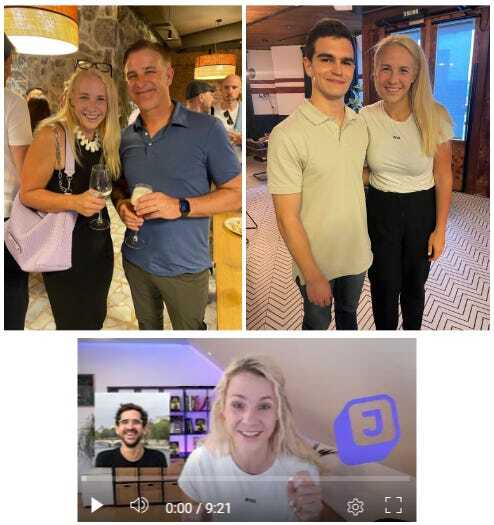 In June, I had the pleasure of brainstorming with multiple B2B influencers. I work closely with 18 content creators to change best practices. 📸: Seal Ellis (Hacking Growth), Ruben Domínguez Íbar (VC + 5th biggest LinkedIner in Spain), Enzo Avigo (Founder of June.so & Y Combinator alum).
In June, I had the pleasure of brainstorming with multiple B2B influencers. I work closely with 18 content creators to change best practices. 📸: Seal Ellis (Hacking Growth), Ruben Domínguez Íbar (VC + 5th biggest LinkedIner in Spain), Enzo Avigo (Founder of June.so & Y Combinator alum). I sent this Substack to 8 more experts to review and featured some of their statements. When I teased about it, 100 comments under my LinkedIn Teaser resulted in 2 more calls with B2B agency owners.
So I guess we are solid. 🤠
I acknowledge that not everything can be measured to a cent and that the only time to value a collaboration is not “7 days after posting.” But my ambition today is to transparently share the best practices and recommendations I give to companies that are thinking about partnering with content creators on their Go-to-Market mission.
Have an influencer strategy in place; don’t do “random collabs”If you are a pre-product market fit, you cannot simply lay all your hopes that influencers will magically pick up your affiliate link. That takes MUCH more work and traction. Sure, you can go ahead and sponsor Lenny’s Podcast. It is guaranteed to bring you a traffic spike, which may be a great place to start. However, if this is not available to you right now or even if you have done it, saw good results, and want to scale your influencer channel, here are the types of influencer partnerships that you can consider:
Organic ReferralsA content creator loves the product and shares the excitement for it free of charge. It is a dream scenario, but it can only happen once you have a great Product-Market fit and lots of customer love.

Examples & best practices: AuthoredUp LinkedIn content management tools generate hundreds of thousands of impressions with user love, which they diligently appreciate on social media.
Barter CollaborationsIf a creator is interested in or already using a product, a company, and the creator can agree on “barter”—free usage of the product is exchanged for promotions.

Examples & best practices: Riverside offers content creators free use of their premium plans to promote them in their podcasts. Although such partnerships are inexpensive, they can be hard to monitor if executed well.
Passive Affiliate through marketplacesThe transaction only happens when the sale is made. An influencer gets 10-50% of the commission for a sold product, either a life-long or time-limited commission.

Examples & best practices: Partnerstack offers many options to receive referral fees for the software you promote software. Companies like Webflow, Figma, Apollo.io, Quickbooks, Notion, and Pipedrive offer partnership programs.
Active affiliate - own programsMany companies decided to launch their own affiliate and referral programs. You can register on their websites, and they will confirm if you are eligible for the program. My affiliate program is here: https://store.gtmstrategist.com/affiliates

Examples & best practices: Salesforce, Miro, Figma, Adobe, and Hubspot offer affiliate deals to qualified content creators. The issue with this one is that most affiliates are passive. This is why such programs need to be managed.
Media BuyingA company pays an influencer a fixed price to buy “media space” from them. That placement usually does not involve much collaboration between parties; you are “buying the audience.” The traffic is generally measured by a UTM link and reported by the number of impressions, downloads, and clicks.

Examples & best practices: Companies sponsor podcasts, Substack, or social media posts. Most content creators publish or share their media buying packages and arrange this. Here is the list of sponsors of Lenny’s podcast. The list includes companies such as Miro, Maven, Amplitude, Superhuman, Coda, etc.
Hybrid CollaborationA company pays a smaller fixed fee, and a revenue share (usually 10-30%) is calculated based on the usage of referral codes.

Examples & best practices: Clay is killing it 🙌. They work with multiple outbound and GTM experts to create new use cases and best practices for using the tool. They diligently create content that best suits their audience. Clay for Creators is a program that supports the next wave of go-to-market content creators. The creators get a 20% commission and some fixed payments.
Launch CollaborationA company teams up with an influencer (preferably multiple influencers to appear everywhere) to co-create and execute the launch campaign.

Examples & best practices: When Amplitude launches new reports, they team up with content creators to co-create and review them. It boosts the reach and increases the relevance of the report launch because influencers share their personal takes on it.
Event CollaborationA company and content creator collaborate to co-create, promote and execute the event. The deal is usually fixed, and a target is set for the number of registrations the campaign should drive.

Examples & best practices: Userpilot hosts bi-monthly webinars featuring influential guest speakers. Initially, they conducted these webinars solo, but after inviting guest speakers, they noticed that registrations doubled or even tripled. This increase is likely because people are more inclined to join when they see a familiar name. They select speakers based on the webinar topic and their area of expertise, typically a month in advance, and collaborate with them on the format.
Additionally, Userpilot organizes an annual online conference where over 10 top LinkedIn influencers share their expertise for free, says Lusine Sargsyan, Demand Generation Manager at Userpilot.
Strategic co-creation of the productThe content creator is involved in the product launch and is a part of the go-to-market strategy. Often these influencers are stakeholders or co-founders of these tools.

Examples & best practices: Lempire founder Guillaume Moubèche supported the launch of Taplio, which was a considerable credibility and adoption booster for their launch. They also work with Justin Welsh. This social proof is featured on the website https://taplio.com/.
OK, so now we have a rainbow of many things that we could be doing with B2B influencers. Now, let’s get some work done, folks! ✌️
How to kick off your B2B Content Creator/Influencer ProgramA natural first step in selecting influencers would be to ask your target market, “Which influencers do you follow?” to get ideas and inspiration. 💡 If you do that, you can pitch the influencers by telling them that your community members suggested the collaboration - it helps with conversion.
There could also be could be a sweet moment of serendipity is finding influential users who are already happy with your product and doing deals with them. Imagine the passion that they can put into collaboration.
As good as this sounds, it is not always available. Most companies that start with media buying and affiliates often fall flat if the product still strives to achieve product-market fit or should be carefully managed as a partnership program. And here is one more thing—even if you manage to excite people to take the product for a spin, there will be a bitter disappointment if the product is not ready for the masses.
If you are starting out, it is best to follow the do-it-yourself approach—find a couple of influencers to work with, work closely with them, and evaluate collaboration based on results.
Here is a list of tools that can help you manage the influencer collaborations:

You can also select Done for You services - agencies, freelancers or platforms that will help you curate the collaborations.
Long story short, when I work with companies new to influencer marketing, we usually select 5-10 influencers, test budgets, and manage the first campaign by ourselves to get a feel for it. I try to avoid “putting all the eggs in one basket.” Testing on a smaller scale and doubling down on what works well usually works best.
How big should the influencers be, and how much should we pay them?
Collab is either a single post/mention on their channels (lower price spectrum) or higher engagement forms such as events, webinars, and materials co-creations.
But the audience size is not everything. What is mission critical is that the content creatior is a good fit for your ICP. When you work with them, always demand audience breakdown data, study their engagement, especially engagement on other promo posts and think very critically is a collaboration would attract relevant attention. I have seen nano creators with 2K followers convert well and 100K creators fall flat in converstions. Think relevance first.
Joran Hofman, founder of Reditus affiliate software and content creator who is in the same content collaborator group for podcasters as I am (Innovators can Laungh) explained:
“When you are going to start with influencer marketing, check your own network first. Who already uses your tool and has a big following under your ICP?
Doing this will help you get the ground running fast, as you don't have to educate them on your tool, and they can create content quickly.
You can leverage this content later when you start recruiting influencers outside your network. It will help them to understand what good looks like, and what is performing well for others.”
 In Reditus, you can match your ICP with the real audience of an affiliate - based on Google Analytics, LinkedIn, or YouTube data. If that is not an option for you, ask for screenshots and audience stats from their LinkedIn or Substack.10 criteria that I use for Influencer selection
In Reditus, you can match your ICP with the real audience of an affiliate - based on Google Analytics, LinkedIn, or YouTube data. If that is not an option for you, ask for screenshots and audience stats from their LinkedIn or Substack.10 criteria that I use for Influencer selectionLet’s see how this looks like in practice. When I am deciding on yay or nay for a certain collab, I use this checklist as a shortcut for my decision-making - some elements are scientific, some are not, but for me “easy to work with” is a huge one because I do not have time to chase around influencers when will they publish their posts 🙈 (too high opportunity cost).
Let’s make this simple—Here is the checklist that I use when selecting influencers to work with in my business:

Less than 7x “yes” would make me reconsider the collaboration.
If they have worked with brands I am in touch with, I would also ask their past sponsors if they were happy with the collaboration and required screenshots of past results and case studies.
To bring in more juice - this is an example of proposals I am getting for collaborations. It is nice, short, and sweet. It provides the:
Context - why is this relevant
Firm reference - I can trust a partner; other creators I admire have worked with them.
A specific proposal - what we could work on, not some “let’s have a brainstorming call” vanilla pitch.
Openness to my creative freedom.
It seems personal enough to me - not sent to 500 other addresses.
Bonus points: if he included a link to a 15-minute chat, I would book a call immediately

This email is good, too, because it is honest. It is obviously not a paid collaboration, but I see value in it for my community and an opportunity to do something cool together. They are willing to invest resources.

And that probably makes you wonder- what is a “fair value exchange” in these deals?
I am happy to collaborate pro bono with early-stage startups as long as the product is free, useful for my audience, and actually works. But please, I do not have time or energy to test “random software,” so help me decide if we are a good fit by highlighting what is in it for my community: founders, product managers, growth experts, and part-time builders of awesome products.
A “fair price” depends on the audience's quality and the quality of material/complexity. I usually produce video demos, rich content materials, and deep dives that companies like to use in their other market materials. Therefore, I could charge a premium. A colleague with more followers could charge a premium because her audience is analytical and expects that are hard and expensive to reach elsewhere and, therefore, have reasonable conversion rates. Most semi-professional content creators have their media/sponsorship packs. They should be able to name the price if you contact them for collaboration. You can always negotiate and adjust the scope to fit your budget. It does not hurt to ask.
After the deal is sealed - the real work begins.
Let’s wrap this up, shall we ✌️
Here are best practices for influencer and content creators collaboration for companiesMost creators require at least some payment in advance when working with new brands. There is a risk on both sides that is fair to be distributed. My best practices how to reduce the risk of collaborations for both sides are:
Agree on a goal of cooperation and write it down - some examples: number of registrations/signups, number of impressions, number of clicks - most influencers will not agree to sales numbers if the purchasing cycle and time to value is longer
Work with batches of influencers 5-10, not a single influencer at a time, to create a synergy effect
Write a written agreement (at least an email will do) in which you define a timeline. Also, agree on communication channels.
Follow up on milestones, send reminders when the deadline is not met, and overcommunicate when necessary.
Prepare a clear brief - what do you expect from collaborations? Mention UVPs, USPs, preferred features to show, and benefits to highlight, but remain flexible. Creators know their audience best. Some creative freedom goes a long way, making the post more credible. Do not treat content creators as billboards - or if you do, at least send them some swag to wear when they are repeating your script 😃 (forget that - it is a terrible idea).
If you are new to influencer collaborations, you should review the materials before they are published and ensure they are published at the arranged time.
Set up a UTM link and unique promotion codes to trace the traffic and conversions.
Try to include a special deal for collaborations whenever possible - WHY now is the question you need to answer together. My most successful collaborations were videos in which I quickly displayed the value - of doing something the audience wants in X time and hands-on tutorials.
Agree on metrics and when they have to be reported
Support creators’ posts as a company to add to its credibility and traction
Whenever possible, agree to do more than one post. It takes time and reps to win over new audiences, and the creator gets better at serving you in multiple collabs
Exchange numbers - often, creators seek feedback loops from companies, but they do not always get it. Ideally, we would know.
Why is this important? Because we do not see links on LinkedIn, especially if you provided your UTM link, we do not know how well the campaign went, and we rely on vanity metrics such as the number of impressions and engagements, but you also want clicks and leads, right? Let’s work together to create the best results possible! ✌️
And the final value gem 💎 in this post goes out to my fellow content creators and influencers who are putting so much love and time into their content ❤️.
Best practices for LinkedIn/Substack/Podcast B2B influencersLastly, since I have 80% conversion rates to collaboration (which means I am still too cheap), let me share some advice with fellow content creators to make collaborations smoother for everyone.
Decide on the partnership policies— who are you working with? I only work with products that I or my partners use in the business, and I demonstrate the value of tools by tackling real GTM problems.
Have reasonable pricing in place. Look, it is not the partner’s job to do your pricing. It is your job. If you are in a dilemma about how much you can charge, use these benchmarks or ask other content creators in your network how much they charge. Most of us are very transparent, and yes, we talk to each other.
Have a Media Pack in place - the collection of your numbers, collaborations, case studies, and audience analysis.
Update it frequently. Your audience grows constantly- you want to revise the media packages every week.
Charge in advance if possible. Larger companies have their procedures and rules for payment, most likely you will get paid 30 days after delivering a service, but if you work with smaller companies, try to get at least part of the payment in advance to secure that both parties are serious around the collaboration.
Take charge of the creative process. Research what they are doing with other influencers and how they communicate as a company. Take the product for a spin and portray your hands-on experience whenever possible. The content will be much better. You are not a parrot. You are an opinion leader.
Act professionally - respect deadlines, communicate in advance when “things happen,” lead the partnership, and communicate diligently with the partner. Engage with their other statuses, too, if you can, and follow the company.
Report back the numbers - don’t let them chase you for the report. Send them screenshots of the placement 3-5 days after the campaign, and ask them if they need anything else. You can also share intermediate results with them if there is happy news. Show how much you care for a successful partnership.
Do not disappear after the campaign. Build a relationship. Suggest other ideas you could do together or other content creators you know would be a good fit. Connect with people on LinkedIn and continue engaging with them and their company's content.
Consider how sponsorships fit into your business model, but most importantly, your first loyalty is to the audience. You cannot be an opinion marker if you lose their trust. In my business, sponsorships account for 10% of my revenue, which is reinvested in our content production process so we can continue sharing cool, non-gated content such as this post with you. It takes me 10-20 hours a week to work on content, and I have two people who help me with editing and design. I see supporters of this Substack as a vital part of our ecosystem and celebrate their wins and milestones with them. We are in it to win it together. Be selective and conservative with the number of partnerships you compare stats of promoted posts with your stats. If you see a huge negative difference, you are doing something wrong.
Last but not least - do not sit around and wait for the opportunities to come by. Be proactive. Prepare case studies, gather testimonials from partners, and when you see an interesting collaboration that a brand has with the content creator, suggest working together. Or pitch companies that you love if they have some collaboration options. You can also join groups of content creators to get a pipeline of these deals. If you are interested in that - email me and I will consider doing some intros based on your traction and expertise. Email grow@majavoje.com only, please; my LinkedIn DM is swamped.
Giddy up and let’s unleash the power of independent content creators to fuel your GTM!
 In other news:
In other news:This week, I published an amazing piece with Ben Williams from Product-Led Geek.
I really admire Ben’s work, so I was more than happy to collaborate with him. In our piece, I shared 5 proven Go-to-Market frameworks everyone needs to know. People loved it - will you? 😇
My new product—The 100-Step Go-To-Market Checklist—is selling like crazy! I’m so happy about all the positive reviews I’ve received—THANK YOU! I will regularly update the assets with new and additional examples.
This feedback from one of the early customers, Nico Trofim-Bancila, was music to my ears:
Your GTM checklist is a fantastic companion for anyone who needs to be guided by a friend through the ins and outs of GTM.
As a use case, not only did you cover a product lunch, but your steps apply to a company launch as well.
What sets your checklist apart is 1. how you combined growth marketing elements with product marketing and 2. how you enlisted so many specialists so together you could create this step-by-step checklist.
I see it as a great combination of the strategic direction and tactics approach.
Very well done, people using it will benefit from it a lot!
Not need to reinvent the wheel with such a powerful tool in place.
Huge kudos, Maja, for another successful and applicable product!

Until next time,
Maja
June 28, 2024
100-Step Go-To-Market Checklist ✅ Launch Analysis

This Substack is kindly supported by Clay
Outreach is so much easier if you have good data about your target customers. Clay is data enrichment tool that helps you go from campaign idea to outreach in minutes. It is trusted by more than 100,000 leading GTM teams of all sizes, including Intercom, Notion, and Clickup.
I am partnering with Clay to create a free email outbound course that will take you from 0 to outbound hero in merely a week. Please fill in this super short survey and help us shape the curriculum that best suits your needs.
Dear GTM Strategist!
First of all, thank you for your incredible support of the launch of the 100-Step Go-To-Market Checklist. Substack was one of the best channels for the launch. THANKS to you ❤️
In this edition, you will get:
A deep dive into my recent launch of the checklist (12-page analysis)
The new edition of one of our Hero Graphics: Growth Loops that I was working on with Ognjen Bošković (ex. Head of Growth at CXL)
Invite for a FREE outbound course with Patrick Spychalski, Content Manager at Clay.
Interview with Adam Robinson who got RB2B to $800K ARR with LinkedIn organic content
Lessons learned at the Product Hackers conference in Madrid (Sean Ellis, how Amplitude relaunched their community, how Skyscanner prioritizes experiments, etc.)
Let’s catch up with the recent updates, shall we?
The 100-Step Go-To-Market Checklist - Launch Analysis
Overall, we passed the goal of $10K three days after the launch, and the responses are through the roof. I documented everything about this campaign in the spirit of transparency and knowledge-sharing.
In this 12-page deep dive, I amassed the launch and shared:
Screenshots of real results
Copy for website, launch, and other campaign assets
Listed the structure
Feel free to apply this proven Five-Figure Launch formula to your business.
It's a powerful tool that can help you achieve similar success in your future launches.
I think publishing a teaser post before the main launch was mission-critical. By sending the document to 1500 people who wanted it, we extended the launch spike, which usually lasts 3-4 days, to 7-8 days.
Do I smell a growth loop?
Yes! This could be classified as a viral loop.
The new edition of 5 Types of Growth Loops hero visualWhenever someone talks about 2010s examples, I roll my eyes a bit and wait until it ends. The business is moving faster than ever, and so should we. While I respect the legacy and have no problem quoting ancient examples, I am excited about all new developments.
This is why my ally Ognjen Bošković (founder at Raven, prev. Head of Growth at CXL) and I revamped 5 Types of Growth Loops to feature more up-to-date examples since the first edition of this post seven months ago.
Here is the recent version of it.

Do you like it?
You are welcome to use it in your content if you find it valuable. If you tag me, I will support your post.
🖼️ I also asked my designers to work on the gallery of all 200+ visuals from my LinkedIn posts and categorize it nicely in Notion for you to reuse and learn from. Some content creators sell such collections, but I will give it to you for free in July as a token of appreciation for your stellar support for the 100-Step Go-To-Market Checklist launch.
Sounds good?
Free Email Outbound Summer School: From Zero to Outbound Hero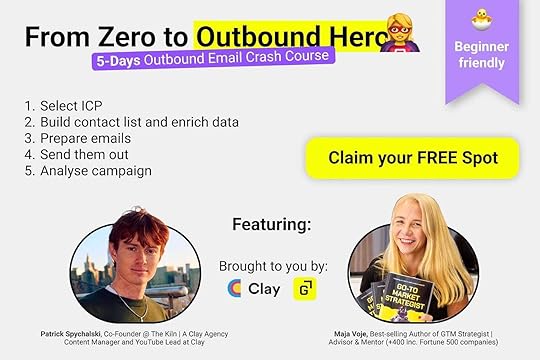
Patrick Spychalski, Content manager at Clay, and I aim to launch a free email outbound course. It will take you from 0 to outbound hero in merely a week 🎓 !
To nail the curriculum, we need to know:
- What business are you in?
- What challenges are you facing with outbound?
- What are Growth Motions that work well for you now?
Please fill in this super short survey and help us shape the curriculum that best suits your needs.
The course will be launched in July.
If you participate in this research, you will get immediate access to the course when we launch.
I promise it is not going to be some shit promo material but a real side-by-side case study that you can apply to your business.
This week, Clay has announced that they raised $62M in total funding at a $500M valuation. It’s an additional sign that this tool has a bright future. Congratulations!
Podcast: How Adam Robinson got RB2B to 800K ARR with LinkedIn organic contentAs a founder or a busy professional, it is really hard to prioritize content creation. I spend 10-15 hours a week producing content, and to be blunt - it has opportunity costs. Either a weekend that I will never get back or a trade-off to do client work or marketing activities for my products.
I am not complaining. I am being real with you.
The bar for content creation quality is higher than ever, and the ROI is very uncertain when you start out. You give, give, give, send your content to oblivion first and “hope for the best”. If you consider inbound as one of your 2-3 winning growth motions, get ready to invest at least 2-3 months to kick it off.
Adam Robinson, founder of Retention.com and RB2B, took this notion to the extreme, and it paid HUGE dividends for him. As a founder, he spends 20-30 hours weekly working on organic LinkedIn content and podcast appearances. His investment resulted in the almost instant creation of $800K ARR when he launched RB2B, a tool that enables B2B businesses to identify their website visitors.
I invited Adam for a podcast chat to get more insights for you how to utilize LinkedIn for organic boost of your go-to-market journey.
You can listen to the audio episode on Apple Podcasts, Spotify, or find it in your favorite podcasts app.
5 Hot Takes from Product Hackers Conference in MadridIn my wildest dreams, I could not imagine that I would share the stage and have a book signing with the growth hacking legend Sean Ellis. First, let me give a giant kudos to the Product Hackers team, especially the legendary CMO Jose Carlos Cortizo Perez (Corti) who was the heart and the soul of the event that brought together more than 600 people from all over the world.

Here is crème de la crème of insights:
Sean Ellis (author of Hacking Growth): Sustainable growth is centered around a carefully selected North Star Metric. The number of experiments you run is directly related to how fast you can grow. That has been demonstrated numerous times (Amazon, X, Dropbox, Meta).
Yara Paoli (prev. Head of Growth at Skyscanner, consultant to Semrush): Where traditional experiments prioritization methods (ICE, RICE, PIE) fail to deliver actionable guidance, consider using logarithmic prioritization of your experiments.
Esther Kim Trapadoux (Growth Marketing and Community at Amplitude): I personally interview all community members. When you are building a community, ask yourself why this community should exist.
Jorge Bestard (Head of EMEA Sales at Canva): 75% of the workweek from salespeople is prospecting, data enrichment, research, and entering data into CRM. Only 25% accounts of the time is spent on actually doing the sales. I see huge potential in utilizing AI to super-charge sales departments. Tools like Gong and Clay could replace the need for CRM in the future.
Tomás Pueyo (Creator of Uncharted Territories - 90K Substack): In content, hooks are 50% of success. You need to start with a goal or a problem your audience cares about. Never jump straight to the solution.
There were many more insights, but let’s slowly wrap up this post.
But do I smell new podcast guests?
Oh yes - new podcast interviews are coming soon!
Last but not least…
Last chance to get The 100-Step Go-To-Market Checklist $30 OFFNext week, we are back to the long, value-packed format, but I hope you do not mind if I sent this shorter edition instead of crickets this week.
Hope I managed to deliver value.
Here is my last invite to get your copy of the 100-Step Go-To-Market Checklist at the promotional launch price of $67. This weekend, the price will increase to $97.
My VC colleagues said I am crazy to sell it at 2-digit price. They valued the list at $500. Call me crazy all you want, I am optimizing for adoption here. We are on a mission to help 10,000 companies cross the chasm this year ✌️That is my North Star Metric that I am optimizing for.
With love for and from Madrid,
Maja
June 20, 2024
My 100-Step Go-To-Market Checklist ✅ is live
I spent the last 5 months squeezing a decade of my GTM experience working with Google, Bayer, and +450 startups into a step-by-step guide. This is the result:
The 100-Step Go-To-Market Checklist (get it this week and get $30 OFF)

To understand it, you need to understand two things I’m fighting hard against as a GTM advisor:
Outdated, out of touch advice coming from the Silicon Valley: no, you won’t find success if you try copying behemoths like Uber and Airbnb
Oversimplified advice coming from ‘scholars’ who only theorize from their ivory tower and never help you actually execute
This guide is the end-product of this fight of mine.
Here is a sneak peek 👇
This checklist is built to give you a go-to-market framework that satisfies this criteria:
It comes from my real experiences in working with everyday companies like yours
On top of that, I’ve compared notes with the best GTM strategists in the world (from Amplitude, Miro, Userpilot, Paddle, Foreo…) and added their perspectives and advice
It doesn’t stop at telling you WHAT to do; it shows you exactly HOW to do it
It helps you execute and achieve your specific GTM goals, not just drown you in more useless information
It will provide you with the exact next step on your GTM journey, regardless of the stage and circumstances

This has been my North Star Metric while building this product, and based on feedback from beta testers so far, I’ve succeeded with it.
Here’s what they said about it:Lusine Sargsyan, Userpilot: “Trust me when I say this - with Maja's GTM Strategist and checklist in hand, you practically have all you need to launch a product successfully.”
Jim Huffman, GrowthHit: “Maja has done it again! This list is a game-changer for growth marketers.”
José Carlos Cortizo, Product Hackers: “If I had had this before launching many of my projects, I would have achieved better results while saving a lot of time and resources along the way.”
Jamie Reynolds, The Product Coach: "I recommend Maja to every single founder and product team that I work with. I would eat her book if it would help me absorb her amazing GTM lessons faster. Using the frameworks & guides in her 100-step checklist gives you the ability to rapidly put her lessons into practice.”
 Alpha testers of this list had a wow 🤩 moment immediately
Alpha testers of this list had a wow 🤩 moment immediatelyAfter selling +5,000 copies of my book (GTM Strategist) on Amazon and getting 6 bestseller badges, I know your expectations are high, and honestly, mine are even higher.
If you get it this week, you’ll also get $30 OFF.
Read all the details about it here:
Welcome to the GTM Strategist 3.0 era.

June 14, 2024
Organic reach on LinkedIn is 1/3 what it used to be in Q1
Dear GTM Strategist,
You know that LinkedIn is one of the most important channels if you target B2B, right? You might not know that LinkedIn has recently changed the default placements in the newsfeeds, which now contain:
Sponsored Content & Ads: almost 50%
Preferred Content Creators: almost 24%
Other Content Creators: 18%
AI Generated Content by LinkedIn: 6%
Organic Company Page Content: around 1,5% (almost invisible)
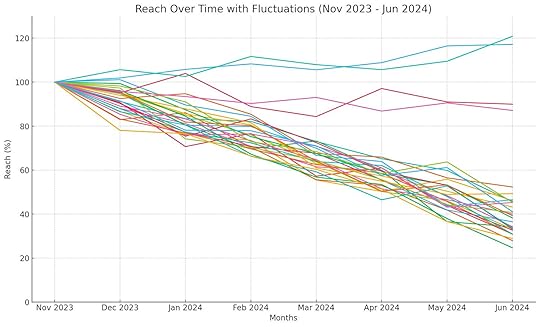
Richard van der Blom reported these stats by analyzing his content creator network.
𝗣𝗲𝗿𝘀𝗼𝗻𝗮𝗹 𝗣𝗿𝗼𝗳𝗶𝗹𝗲𝘀:
Impressions: down to 30 - 40%
Follower growth: down to 35 - 45%
Engagement: down to 70 - 80%
Impact of Top Voice (collaborative articles) on reach: none
𝗙𝗼𝗿𝗺𝗮𝘁𝘀:
Carousel (aka PDF aka Document): down to 40 - 50% (!)
Text Image Post: down to 30 - 40%
Native Video: down to 75 - 85%
Polls: down to 40 - 50%
Does that mean the end of the golden era of LinkedIn inbound for B2B is over?

Nope.
Here’s the evidence of why I think so.
1) The analysis of my own LinkedIn data (ca. 50-100K weekly impressions).I analyzed my LinkedIn reach, and while it is true that it was harder to create viral posts in Q2 than in Q1 2024 and Q4 2023, I also have to admit that I have been swamped with client work and could only spend up to 10 hours a week on creating content.

This is not nearly enough - an average content creator of my size invests at least 20 hours a week creating content, best in best-in-class people, such as product legend Aakash Gupta (211K), is closing in on 40 . The bar is very high. But, when you are in it to win it, you can still break through. Thank you for your incredible support of my GTM Power Hour template. We crashed it! ✌️

Well, you might be thinking: “Maja, we get it. It makes sense for you to do it because you are generating demand for a Go-To-Market Strategist” (that you should totally get if you have not done it already 🤠). Over 6,500 people have read the book so far, and we have only had 6 refunds, so it must be great.
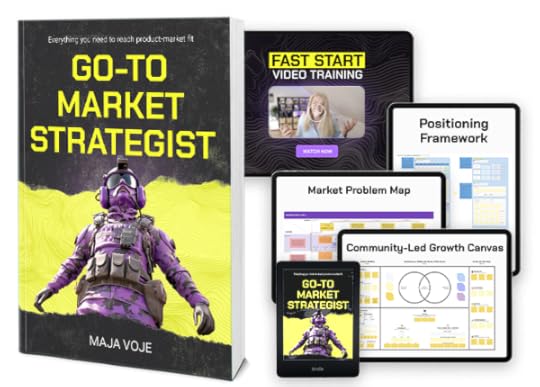
I get it - because, guess what, I am a busy founder too, and I have to make time for client work, working with my team members, developing my products, and everything else that comes in the pack.
But sincerely, if I built a B2B SaaS or enterprise product, I’d be even more present on LinkedIn because, in crowded markets, people still buy from people. LinkedIn can be one of your business's best demand generation engines if you “get it, " connect with the right people, and create a critical mass there. Here is why:
2) Multiple founders who adopted building in public reported stellar results.I recently interviewed a rising LinkedIn star Adam Robinson, CEO and founder of Retention.com and RB2B - BTW, he has one of the best positionings for products that I have ever seen on LinkedIn. You can grasp what is “in it for you” in 3 seconds. Extremely well done.

Adam does epic build-in-public videos on LinkedIn that generate tens of millions of relevant impressions. He invests $50K a month in his LinkedIn demand generation engine:

Here is a copy of his presentation.
This investment created unseen traction for their person-level website identification tool RB2B that “money cannot buy”. For the launch, I have seen teams spend way more than that for events, PR, and media buying to get maybe 1/10 of the traction that RB2B got.
Adam reported: “In 13 weeks, we grew RB2B from $0-$806k ARR with 4 people and zero funding. But we have a *broken* PLG model with a 1.3% conversion rate.” He plans a switch to a Sales-Assisted PLG model.
I’ll publish my interview with Adam Robinson on the GTM Strategist Podcast next week, so subscribe to avoid missing it!
3) Ivana Todorović (founder of AuthoredUp, a content creation tool for LinkedIn) and her team analyzed millions of LinkedIn posts and built data models to analyze current trends.Every year, an independent LinkedIn algorithm report study shapes how we think and do LinkedIn.
 Here’s Richard van der Blom’s latest report
Here’s Richard van der Blom’s latest reportThis year, I was happy to learn that a person from my region is crunching this data with machine learning. So I met Ivana in Belgrade, and we had one of the best conversations about LinkedIn that I have ever had.

As a founder, Ivana strongly encourages knowledge sharing. Instead of impressions, we should be chasing relevant attention and actions taken from our ICP. I also wanted to bring the insights from our conversation to you, so we recorded a podcast episode to recap the main lessons learned about why you should pay attention to LinkedIn in 2024 and how to get above-average results on the platform.
It’s a value-packed interview. I especially recommend listening to the second half, in which Ivana shares numbers and many tactical recommendations.
Listen here:
You can also find it on Apple Podcasts, Spotify, or other podcast platforms.
7 LinkedIn Hotfixes: My commitment to up my LinkedIn game this summerFrom interviewing Ivana and Adam, it became clear that I could also step up my LinkedIn game. Here are my 7 hotfixes based on research:
Value commenting: LinkedIn wants you to “act normal” on the platform, not to post and disappear. Your post will gate a base level of impressions, the rest is strongly associated with your ability to spark conversations in comments. Value commenting to other content crreators posts is also a great strategy to grow your audience. How about 5-10 value comments to selected content creators before you post? I have tested this tactic by commenting on the creators of The VC Corner Ruben Dominges Ibar’s post (112K followers) and the immediately got engagement and sales (thanks bro 🙏)

Post from personal profiles instead of (only) company pages: this one is more for my clients than for myself. Based on my data, the reach of personal profiles is 10-30x bigger than company pages. If you still rely on sharing your blog posts and company team-building pics on LinkedIn, it is about time to consider something else.
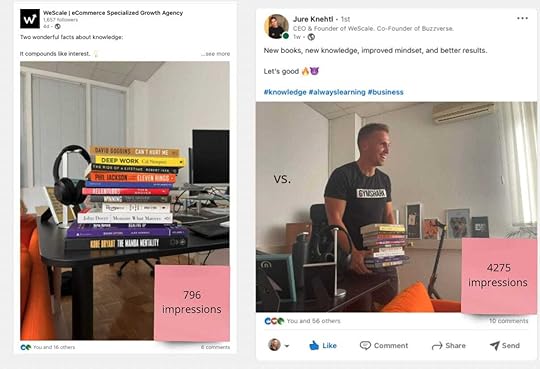
Experiment with more formats: if a certain % of newsfeed impressions is reserved to a certain format, I must diversify my content formats even further. ATM I do image text, carousel and video. I should start adding text only and use other LinkedIn features such as polls more othen. Ivana says that polls once a week could be great for engaging with the audience on weekends. I will give it a shot.

Get better at writing hooks: Adam said that he spends most of his content planning meetings thinking about hooks for the week. 🪝Hooks are the magic first two lines of posts that will determine if the reader will click “see more” or continue scrolling in the feed. Posts should be optimized for mobile where the majority of LinkedIn content is consumed and should be easily readable (enough white space). Ivana shared her list of hooks tested to work. I will also try AuthoredUp to get better at this.
Do content creator collabs: “Stronger together” is so true. In May, I was lucky to work with Aakash Gupta (110K Substack) on this epic post, and I am so happy with the results. Sure, we spent more than 30 hours on this article (both of us), it was quite an intense collaboration, but it was so good. When you work with content creators with an audience that is close to yours, you can both benefit. I am a shrimp in comparison with Aakash, but I was happy to engage strongly and provide additional models for the content collab. Incredibly grateful for this chance 🙏

Use LinkedIn groups: if you find high-quality LinkedIn groups (10K members) that are active and relevant to your ICP, you could generate a lot of extra impressions if you post valuable content there.
Talk about AI 😅: it seems that lately, LinkedIn is favoriting specific content topics around AI. Also, engagement (your comments) on AI-generated content gets more visibility than the average comment you leave on content from your network. 🤖
To test my newly acquired knowledge, I collaborated with growth expert Jim Huffman, CEO of GrowthHit agency, and I love using it for our campaigns …

It did not immediately go viral just because I mentioned AI, but hey - learning by doing.
Fighting AI-generated content seems like

While, to my best knowledge, AI agents cannot yet transact with each other without human-set rules, business transactions are still done human to human. Optimize for high-quality human relationships, do well in business and use tools to your advantage to increase operational efficiency.
And you will have plenty of business opportunities during and beyond your go-to-market journey.
See what best in class content creators are posting - I analyzed 199 posts and their profiles.
If you are just getting started, here are 5 LinkedIn post templates you can start with.

No excuses.
Let’s go to market.
And win! ✌️
Maja
TEASER: We have an exciting launch coming up next week, and as a subscriber to this Substack, you will get a special promo code for early access as a token of appreciation for following my content. Ensure that we are connected on LinkedIn and that you are subscribed to this Substack.
If you enjoyed this one, I’d appreciate it if you recommend it to someone who could benefit from it to spread the word or restack it.
June 7, 2024
GTM Power Hour ⚡: New template that went viral on LinkedIn
Dear GTM Strategist,
How was your May? Mine was insane. We broke all the records—book sales, consulting sales, and the number of companies I mentored. I helped over 100 companies develop or upgrade their go-to-market strategy. Mainly, there were B2B companies, but I never shy away from doing something cool in the edtech and pet space, either. Those are my pet projects.
Usually, I use Miro to coordinate my online mentoring sessions. With the companies that I mentor privately, I go through a robust framework of four modules:
ICP/ECP - how to select the best target audience using the beachhead strategy logic
Positioning & Messaging - how to differentiate your value proposition from the competition by developing a promise to your target audience (UVP) and explaining why you are the best solution to do the job confidently for them (USP)
Pricing & Business Model - where to capture the value (monetization points and dynamics), how to charge (packaging), and how much to charge (price)
Growth - which GTM motions are likely to work best for you, and what tools/channels/assets do you need to test them?
This program lasts 1-3 months, depending on their GTM sophistication and speed of execution. We also have weekly sprints to verify different assumptions and learn from the experiments we run.
But when I was doing field work with the Swiss Entrepreneurship Fund for 10 days, I only had 1 hour with each funder. I wanted to give them a “GTM Strategy snapshot” and ensure they had actionable insights after the session.
I could not use Miro at live sessions; it would be dumb to stare at the computer instead of the person’s eyes. How can I give them something tangible and actionable in an hour without using my go-to frameworks?
Solution = Pen + Paper. I asked the local organizers to provide me with a flip chart, and I created 30+ GTM doodles that companies proudly took home like a diploma from our sessions. They looked like this:
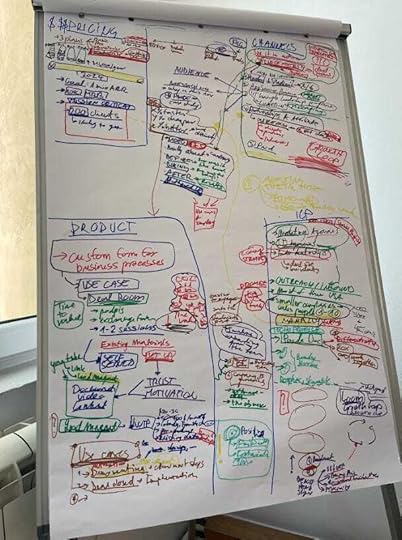
Abstract artists could learn something from my color selection and alignment - as you know …

But I like you, and I want you to be able to read what I write.
Go-to-Market Power Hour - Ideal for a 1h SessionDuring the live sessions, I learned that 70% of concepts are fundamental Go-to-Market concepts that everyone needs to know and consider using, such as:
Concept of ECP (early customer profile)
Beachhead strategy
Go-to-Market Motions
5 stages of Go-to-Market
Positioning and Messaging work
By now, I have frameworks and Substack posts that founders could follow independently to bring the GTM plan to action.
And I was like - wait a minute - I could develop a new framework from this. I do not need a flipchart. I sat down and structured this framework in Miro:

I test all of the frameworks before I publish them. Last week, I tested it with 19 companies. I am happy to report that it works like a charm 🪄
Take it for a spin yourself on the link below. ✌️
I explained more in the latest episode of the GTM Strategist Podcast:
I’m eager to hear your feedback, too! Let me know (in the comments or on LinkedIn) how you like this template and what is most useful to you.

This Substack is kindly supported by Landbot, an AI-enabled chatbot builder.
Over 90% of the questions I get are repetitive:
Where can I buy the physical copy of the Go-to-Market strategist?
Where can I get a receipt for my purchase?
Is the GTM Strategist more applicable to B2C or B2B?
I doubt anyone reads FAQ by now 🙈 and I felt so guilty because it takes me days (sometimes weeks 😅) to reply to all the WhatsApp, email, and LinkedIn questions that I get. This is, of course, not acceptable business practice, so I went ahead and built a cool support bot for my website majavoje.com. You can test it there & build your first chatbot - no code in 15 minutes using Landbot. It is super easy - watch my walkthrough video. Take it for a spin & say sayonara to repeatable tasks!
Do you know that you could automate 90% of customer support like I did? 🙈 The time you spend answering repetitive questions could better be used elsewhere. The faster you reply, the more likely it is that conversions will happen. ✌️
 Source: Vendasta
Source: Vendasta

The Ultimate Go-To-Market Toolkit: From Strategy to Profit
You can get my book GTM Strategist, along with fill-in templates and fast-start video training, at https://gtmstrategist.com.
Till next time,
Maja
May 31, 2024
It is not Product vs. Service - it is a spectrum

This Substack is kindly supported by Clay, a mega-tool for data enrichment for outbound used by over 100,000 go-to-market teams, including Intercom, Notion, Reddit and ActiveCampaign, as well as B2B marketing and sales agencies. You can build high-quality contact lists for outreach in minutes. Take it for a spin yourself and learn more aboututbound as one of the undervalued go-to-market motions in my interview with Bruno Estrella, head of growth at Clay (previously director of marketing at Webflow).
Dear GTM Strategist!
Some of my favorite and most successful teams I mentor come from the service sector and have gradually evolved the products after repeatedly solving problems for a client. In June, I will onboard three such teams:
⚡ One excelled at making smart grids as a service for the Scandinavian market, and now, they want to productize them to cater to other markets. This is smart because the electricity companies are hyper-local and, therefore, not competitive. Potentially, we could build an investable product.
🏦 I also mentored a software development company that produced solutions for banking and insurance and is now successfully dominating the regional market through partnerships with associations.
📹 One of my biggest success stories in Q2 is an original video production company that makes AR (augmented reality) solutions for production companies.

What do these companies have in common? They are all service-born companies that go to market with:
Verified problem-solution fit (they have solved this problem before)
Proof of monetization (clients paid to have it solved)
Established references and case studies (it is not a cold start)
Blueprints and teams that have solved the problem before (experience).
That is some sweet competitive advantage, and one could easily expect that they will parade to the market at unseen speed, but that is not always the case.
In this Substack, we will:
Explore the Product-Service Spectrum
I will share a case of how I scaled my consulting business with the product
Review the concept of the value ladder, which will help you develop offers to increase customer LTV and convert more clients.
Think about how could we algorithmize our brains
Unmask a couple of pitfalls to avoid if you are transitioning from service to product to set you up for a good start.
Sounds good?
Let’s scale services and products this time!
I have a confession to make. For my GTM Strategist book, I was in a dilemma how to define a product? Most go-to-market principles that I described in the book apply to service businesses, not just products in its narrower meaning. This is why I developed this definition:
Product is a medium of value delivery. We have a target market on one side and a company on the other. “Product” captures the value, and delivers it to the customer, which pays the company for the value at a price, which is a value exchange.
Is productization really the holy grail of service business development, and should we all gravitate towards products as the ultimate form of value delivery?
It is true that Guillaume Moubeche launched Lemlist after doing cold-emailing services for years, which led to $150MM validation of Lempire, but it it would be unwise to assume that services should naturally gravitate towards products. It is not an evolution. It is a spectrum.
This image of my colleague Jason Knight, product leader and podcast host at One Knight in Product, made me think very hard. Here is a Product-Service Spectrum, a mental model that I love using at my mentorship session whenever we launch a truly innovative technology product that needs a little training and insights before we can happily announce that a large group of users can self-onboard to the system.
When we go to market, we often have to engage in non-scalable or semi-scalable forms before we can develop the final version of the product. Sometimes, this is because of learnings, and other times, it's because of funding (we need 50K to invest in product development, and let’s invite customers to cover a part of this investment). For easier interpretation, I present an example from an email marketing service—from ghost-writing emails to full-fetched products with a life of their own.

Looks good on paper, right?
But in practice Scaling service businesses is definitely not linear and easy.
There are ups and downs - let me walk you through my own journey.
I started my full-time freelancing career over a decade ago (do not calculate how old I am 🙈). First, I did some European tenders and public writing services for tech companies by subcontracting to an agency. Later, I transitioned to marketing gigs, which I loved.
With one of the partners, we launched a successful Kickstarter campaign, which attracted the attention of best-selling Udemy instructor Davis Jones, with whom I later co-authored one of the best-selling growth hacking courses.
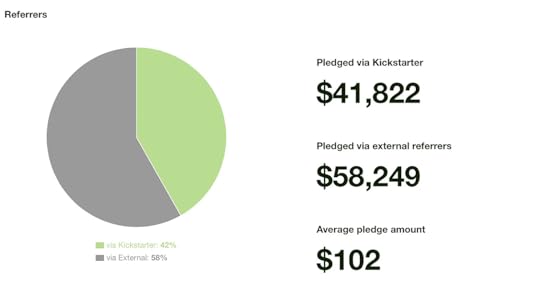
I was still working full-time when the FOMO of getting inbound leads became too much to handle. My first full-time client was a beauty brand from the US—oh look, a pivot to e-commerce. I did a little bit of everything marketing and growth-related for clients in the service industry, SaaS, apps, enterprise—you name it—I did it 😃.
While that gave me a wonderful “range” of knowledge, I was the jack of all trades but not a “world-class go-to” at anything. In each vertical, there were people who devoted themselves fully to the area. Those people devoted themselves fully to something. I was still searching for the right professional obsession.
Sadly, I was also constrained by the number of hours I could “sell” on a weekly basis and was severely running out of time and energy to work on my business strategy. I reached 100,000K a year with services, but I was overworked and snappy on stressful days.
How about if the unit of input would not linearly result in output? For years, I secretly admired people who “made money when they sleep”—no shade, Neil Patel fans. The fact that I was solely dependent on my ability to work and attract business scared me (what about if I fall ill, have a family situation, want a vacation, need a break...). My earnings would be 0.
I started to think more and more about creating assets for my business so that I could no longer be dependent on my ability to have “Zoom calls,” but I would have predictable revenue streams that I could rely on even when I could not work or did not feel like it.
I started with online courses (that was easy for me because I love to teach others). First, I started offering them on the Udemy marketplace to “outsource” the student acquisition problem, but Udemy limited my ability to manage upsells. My earnings were determined by the number of units sold, which is cool if I wanted to specialize only in promoting online courses, but that is not my path.
I prefer to work on real cases and then share my learnings through educational products and content. So I started building communities and partnerships to have a sizable audience for my own launches. One of the biggest mistakes that I see with online course creators is “build it, and they will come.” In order to have a successful organic launch, you need a sizable warm-up audience eagerly expecting the product. That takes months (and years) of committed value delivery.
To make sense of the situation, I learned the golden rule of selling edu products:
It is OK if the frontend is merely break-even.
You make the most money in the backend and with the high ticket.
Luckily I realized that before my book launch because “selling a piece of paper” is really not that exciting as a business. For my Go-to-Market Strategist Business unit, the value ladder currently looks like this:

Here is how it is structured.
First you get value for free ($0) or a fraction of the cost. In my business, these are social media posts, Miroverse templates, this Substack and free online events intended to attract and add people to your ecosystem. 80-90% of the audience will only get that far and this is fine. Often times they will recommend you to others and you have an opportunity to help them.
Frontend is my Go-To-Market Strategist book ($9.99 Kindle, $27.99 physical copy via Amazon, and $47 Go-to-Market Strategist bundle with more templates and an online course) - it is very affordable and widely distributed. This is a DIY - do it yourself way how you can benefit from the product. The conversion rates for my frontend are 10-15% based on the data that I have (I do not get page visit data from Amazon).
Middle-end or an order bump is being under construction at the moment. There will be a new product launching at $79-$99 soon. Obviously, I have no idea what the conversion rates will be, but I am excited.
Backend offer that I developed is Go-to-Market Bootcamp (valued $199 for recordings to $997 ticket per seat when we do it live). In addition to this, I also offer a $400 consulting call to discuss your GTM strategy. These products are “Done with you”- we elaborate on them together.
High ticket is my consulting business, advisories, and interim roles. It starts at $3000-7000/a month for strategic guidance, and mentorship to a team, accountability checks and hands-on help (networking, research, tactics). Due to time constraints, and the importance of focusing on higher delivery, I prefer to stay in the range of 3-5 such clients a quarter.
For me, a high ticket is a hybrid between done for you and done with you. I develop really original solutions with the teams that I reflect on and systematize later for further concept development. So, it is a loop. I need all parts of the value ladder to continuously create and capture value.
Long story short - following the user journey and product-led growth principles, customers need confidence (evidence of delivering value) before they engage in higher-value deals. You need to deliver value gradually and consistently.
It is definitely not a linear journey. Not every prospect travels to the top of the value ladder. But the ones who do, get prime and most valuable insight and guidance, as well as ongoing support and guidance. Whenever I plan offers, I return to Alex Hormozi's formula for an Irresistible offer. It just works.

While I was very happy with my productization at the moment, something started itching …
AI or how to algorithmize our brain: The final frontier of service scaling?My first medium was my voice (online and in-person services).
Many have asked me: “Maja, why don’t you hire more people?”
Short answer: I never want to build an agency.
No shade, but it is just not for me.
I have coached many agencies (development, design, marketing/growth), and they all face the problem of scalability and diminishing returns at one point.
The second was on-demand video.
Later on, I invested in physical and digital products.
I never developed software myself, but I mentored hundreds of SaaS companies on going to market. Most build 50K MRR in less than 6 months. Well, that would be difficult to do as a service solopreneur. It made me think really hard how to get to the top of service scaling spectrum.
While boomers happily share Midjourney art on Facebook.

How cute and useless 😍
I grew to believe that the final frontier of human creativity in consulting is whether we can create “AI digital twins.” How we algorithm our brains seems to be the flavor of the season. What is better is that those “digital twins” could interact with each other and learn exponentially more than we do. I plan to do v01 by the end of this year.
Not to be too abstract, here is a visual of different productization options when transitioning from service to product.
 6 Pitfalls or transitioning from Service to Product A: For Solo Businesses and Small teams
6 Pitfalls or transitioning from Service to Product A: For Solo Businesses and Small teamsLooking back to where I started, there are multiple things I would do VERY differently today, so allow me to share some lessons that I believe to be mission-critical for service businesses that are transitioning to products:
Do not build your business solely around recommendations. An average service business gets 70-80% of clients through recommendations. People trust people. But recommendations are not really scalable, aren’t they? It is difficult to open new markets if you are “stuck” with winning new businesses. This is why we develop multiple assets (offers) to welcome prospects at different stages of their buyer journey and test new channels.
Never charge per hour. An hour is an input metric. It has little to do with the value that you can provide. I can spend an hour replying to emails or planning to launch a $1mio business. You can also outprice yourself with an hourly fee. Yes, some can charge $5000 an hour, but for most people, this is ridiculous. With some exceptions, it is better to charge per day or project. Just avoid setting “hourly rates if you are not a lawyer or a personal trainer.
Choose one niche and stick to it. Jacks of all trades might sell well locally on small and oblivious markets. If your goal is to be “world class” at something, you have to niche down. Select a narrow segment with a burning painpoint that you can build a 10X solution for and stick to it. Become a go-to for something before you move forward.
The real money is in increasing LTV - stop chasing “gigs”- building a sustainable business means setting up repeatable processes to attract, deliver value and upsell the customers. The idea of chasing new clients to “pay the bills” every month is a clear no. The real money is made in the backend and extending LTV. When I started my consulting journey, one of my early mentors, a seasoned consultant herself, advised me: “The company has to have some fat to survive the drain periods. Sell retainers immediately”. I am grateful for this advice.
Not every service has to be rocket science. Standardization is the name of the game. You need to prove that you can deliver value repeatedly. If you are like me, an intellectually curious soul who loves to tackle unstructured challenges, you might be more drawn to solving the next “big problem” - builder mode, than making more money with solutions that you already have - business mode. It is fine if you are supremely well paid or happy inventing “a-la-carte solutions”, but true scalability lies in operational excellence and optimized processes, which only occur when you have done the “drill” of repeating the work again and again.
Productize as soon as possible just to get better at it. If your vision is to provide only services, that is fine, but if you get a bit anxious every time you see someone making 1mio ARR a year and more with their SaaS solutions or a digital product, then you have an appetite for productization, my friend. Early attempts of productization can be super simple. You can sell a template, process, or video recordings of your onboarding processes. Productisation is a new competence to develop. Most likely, it is going to take multiple trials and errors to find the right fit. Start experimenting and learning as soon as possible to get closer to your Product-Market fit.
Cool. If this batch of advice was more for consulting and agencies, let’s nudge it up a notch and share a couple of pitfalls to avoid when transitioning from service to product in a larger team.
B: For larger teams (mostly dedicated to software development agencies)Transitioning from services to products is not a piece of cake. Despite good odds of success, many service companies face the following issues with their productization attempts:
Opportunity cost. Many struggle to devote enough resources to product development because “client money” smells nicer than investing potential billable hours in building their own products. In other words, secure money now is better than “unsecured money in the future”, right? But to conquer the next frontier of your business growth, GTM strategy doctor prescribed risk-taking.
No real buy-in and incompetence to build products. Some people are just comfortable doing their jobs. They have very little appetite for tackling the unknown. If the team does not buy into the productization vision, they will concisely or subconsciously sabotage the product with “nay culture.” In my experience, many people in the service industry just don’t get the product. Instead of “venture building” with existing clients, it would make a much better impact if you recruit experienced product managers and builders and spin off a new venture with a life and lifeline of its own. You need new knowledge and processes to build products.
No critical mass. “Internal incubators” become sandboxes with poor product ownership and hybrid teams that are not really into it. It is highly unlikely to build something great if the team is slacking on the project and trains juniors on their own products. You should empower the product team with the best people for the job and resources instead of letting them “play part-time” for a quarter or so and see what happens.
Optimizing for profit. If the team develops a decent product against all the previously mentioned odds, they often get trapped in their established modus operandi. Their business models are made to optimize for the profitability of services as if products would only be “lead magnets” to attract new customers and extend their LTV (lifetime value) with no clear scaling agenda.
Process superiority complex. Many service companies developed their internal tools and SOPs (Standard operating procedures) that work for them. They try to scale the internal tools that work for them with little to no research and adaptation to what the potential clients actually need. You cannot scale something that was developed in isolation on the sample of one unless you are a rockstar crushing it business-wise and you have a hoard of raving fans who “want to be just like you”.
Turning into an internal agency for a client. Co-creation with customers sounds like a great validation method. The idea that someone else would share the development cost with the customers sounds great, right? Co-creating the product with customers can bring important feedback loops and insights for your work. But be careful there—you need to stay true to your product vision, not snowball all the client requirements into a product. This is an important feedback loop for my product work.

One could come up with more reasons why service companies fail to transition to product, but since they are closer to the product market, fit most “product visions,” and successful productization could skyrocket their service businesses and make them grow much faster, be more investible and easier to exit.
Thank you very much for reading this piece.
Service scaling and transitioning from services to products are very near and dear to my heart because they are challenges that I had to tackle personally to “future-proof” my business.
If you would like what we discussed today and face a service scaling challenge in your business, you are welcome to reach out to grow@majavoje.com. If we are a good fit, I will present you my Service Scaling GTM module that I am testing with 12 mentees at the moment. Maybe one day, it will be a stand-alone product - or not. The market will tell. 🤠

And I hope by now, you are convinced that the principles described in the Go-To-Market Strategist book apply to B2B service businesses as well. ✌️ Take them for a spin and get a huge ROI in applying the principles to your business. Some of the chapters that are mission-critical for service businesses are:
Market and customer segmentation
ECP - early customer profile
Positioning and Messaging
Pricing Packaging and
Growth - Go-to-Market Motions
Check out my other most-loved Substack posts:
Before there is Ideal, there is Early (Customer Profile)



